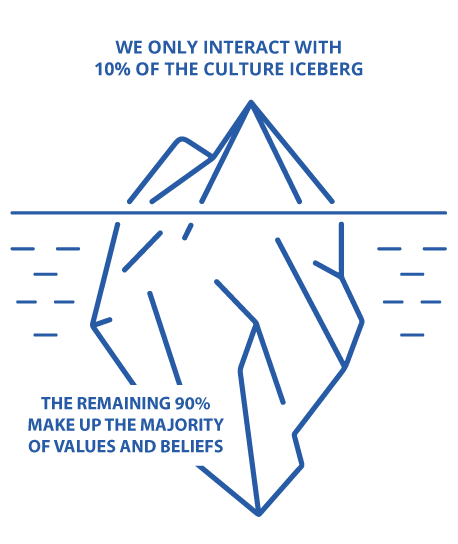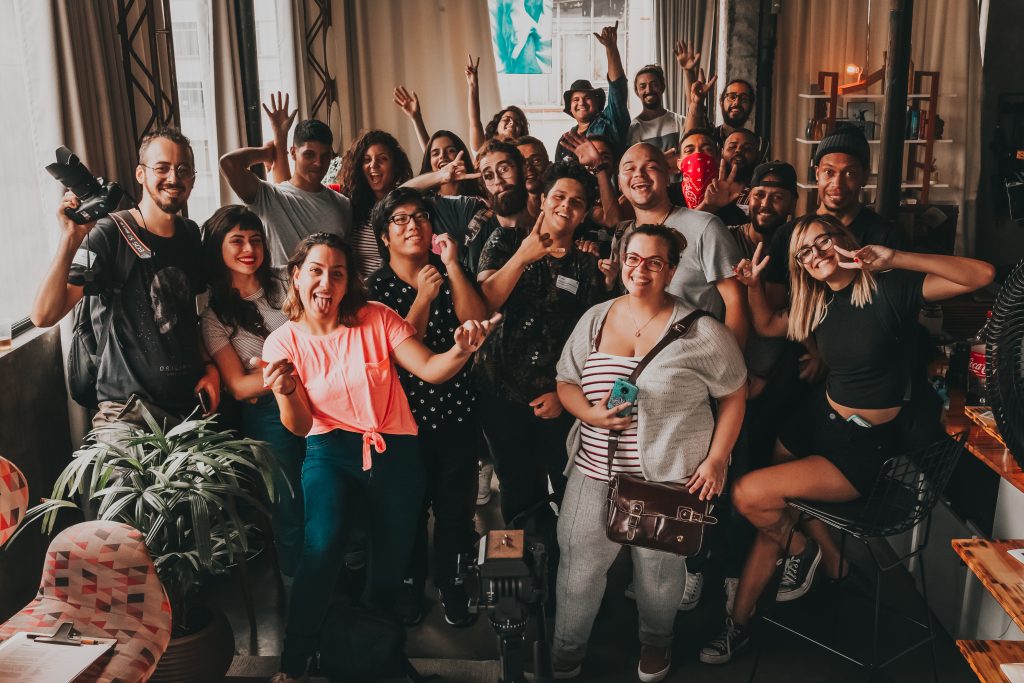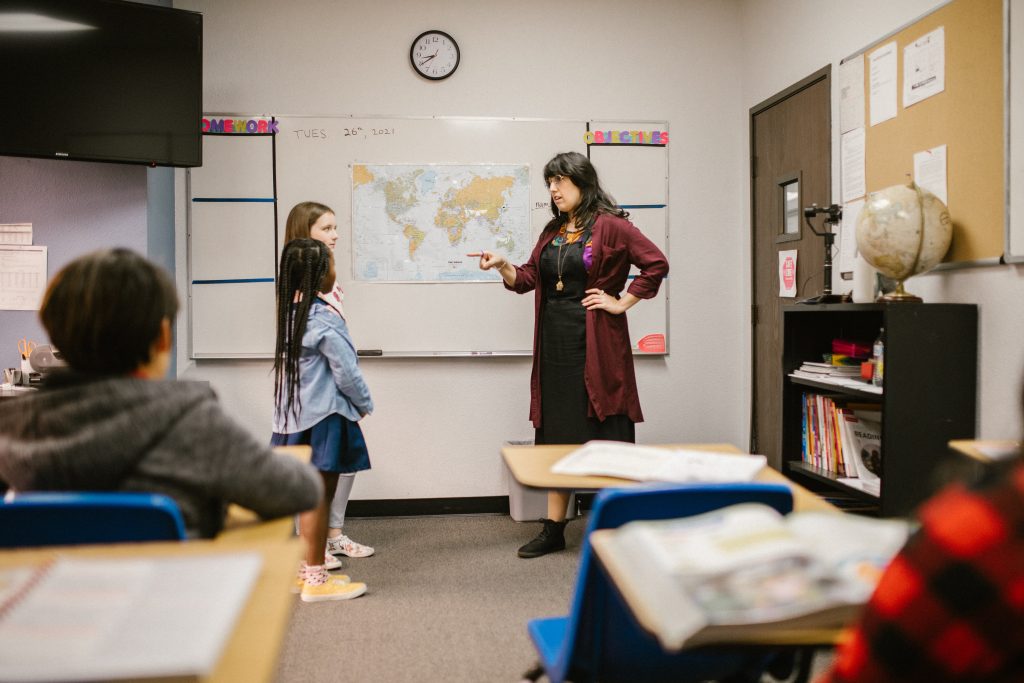Advancing Intercultural Competence for Global Learners
Advancing Intercultural Competence for Global Learners by cmcwebb is licensed under a Creative Commons Attribution-NonCommercial 4.0 International License, except where otherwise noted.
Advancing Intercultural Competence for Global Learners by cmcwebb is licensed under a Creative Commons Attribution-NonCommercial 4.0 International License, except where otherwise noted.
I
1
Welcome to Advancing Intercultural Competence for Global Learners. This program is divided into three interconnected modules to nurture your intercultural competence more holistically.
The estimated time-to-completion is four hours per module, totalling 12 hours for the entire program.

Mossholder, T. (2019). Group of people taking picture. Pexels. https://www.pexels.com/photo/group-of-people-taking-picture-3063478/
You may choose to complete the modules independently if you want to focus on a specific area of development, although the best learning experience comes from a combination of the three modules. Whatever you choose, we encourage you to engage with the content, take time to reflect on what you are learning, be open to new perspectives, and use the strategies suggested in your everyday interactions.
The three modules follow a student-engagement approach where you involve yourself with the content through self-reflection, interactive activities with automatic feedback, summaries of key points, and strategies to support your intercultural development as a global learner.
In every module, you will find interactive activities, definitions, and questions for reflection. You can also follow the links to the Glossary section at any time to expand your knowledge, review terms, or just to have an overview of the concepts used across the three modules.
In this section, you will explore two key concepts, global learner and intercultural competence (IC), in an interactive way. This will help you gain a better understanding of what the program is focused on and what you can expect when interacting with the content.
It is important to ensure you understand what is meant by a global learner to have a clearer idea of what you are aiming for as you immerse yourself in the intercultural learning process.
An interactive H5P element has been excluded from this version of the text. You can view it online here:
https://ecampusontario.pressbooks.pub/interculturalcompetence/?p=508#h5p-21
How close was your understanding of global learner to the definition provided? In what way was it similar? How was it different? In what way does being a global learner help you in your personal and professional life?
Although we often hear these two terms used interchangeably, they are, in fact, not the same, as explained below:
Intercultural (e.g., competence, communication, engagement) focuses on a deeper understanding of interactions between cultures and the mutual exchange of ideas from a more holistic and comprehensive perspective.
Cross-cultural (e.g., communication, studies, or interactions) involves comparisons of different cultures around a particular aspect; for example, work values in Switzerland versus Saudi Arabia, or how people greet each other in Canada compared to Spain.
Since our program content is not limited to comparisons across cultures, you will see references to intercultural competence, communication, studies, interactions, engagement, and so on. Your objective is to develop a better understanding of what happens within, around, and beyond interactions, to equip you with ways to learn about different perspectives, to help you develop skills, and overall to support your intercultural learning journey.
Intercultural competence is a complex process—a multi-faceted set of abilities—that influence the way we interact and think, what we do and avoid doing, the decisions we make, and how all of these affect our own group as well as cultural others.
Perhaps you already have a notion of intercultural competence; even if you do not, there are ideas around it that we need to clarify. Let’s start with that!
Examine each statement below and decide whether they are true or false in terms of your own understanding of intercultural competence.
An interactive H5P element has been excluded from this version of the text. You can view it online here:
https://ecampusontario.pressbooks.pub/interculturalcompetence/?p=508#h5p-22
Intercultural competence development…
Well done!
Now you have a better understanding of what the program is about and what you can expect. Start engaging with the content in the modules and enjoy the journey!
2
II
3
This module focuses on helping you create awareness of your own and others’ cultural selves while introducing strategies to suspend judgement when you perceive people to be different from you. Through the content and interactive exercises, you will engage with real-life examples to understand and appreciate multiple cultural perspectives, as well as to develop the skill of self-reflection, which are important in intercultural interactions.
By the end of this module, you will be able to:
You can refer to the glossary at any time to find definitions of these and other keywords:
Culture, Iceberg Theory, Ethnocentrism, Bias, Stereotype, Microaggression
4
Our very survival has never required greater cooperation and greater understanding among all people from all places than at this moment in history. And when that happens — when people set aside their differences, even for a moment, to work in common effort toward a common goal; when they struggle together, and sacrifice together, and learn from one another — then all things are possible.
United States of America (USA) President Barack Obama (Commencement speech, University of Notre Dame, 2016)
Culture hides much more than it reveals, and strangely enough what it hides, it hides most effectively from its own participants. Years of study have convinced me that the real job is not to understand foreign culture, but to understand our own.
Edward T. Hall, Anthropologist
5
A self-awareness and identity wheel serves as a visual representation of the different parts of an individual’s personal, social, and cultural characteristics; it illustrates the construction of our self-perception and identity. Understanding ourselves by being aware of our identities and perspectives is a steppingstone to understanding how other identities are constructed and how we relate to others.
At the centre of the wheel, you find your unconscious self, comprising who you are as an individual and the elements of your identity that are mostly static and unchangeable. On the outside, you find your conscious development and how you describe yourself based on achievements and what you have gained through studying or working formally and informally. Your geography helps you position yourself in relation to where you live and how you relate to your surroundings. Your choices involve that part of your identity that reflects how you navigate your adult life and the decisions you make along the way. Your perceptions refer to your self-awareness regarding how you believe you are perceived and how you perceive others. Your engagement highlights the way you relate to others around, who is included in your circle of friends, and the extent to which you reach out of your circle of commonality. A part of your identity that combines experiences and challenges is represented as your struggles, which you should learn to recognize to help you understand other people’s pains and troubles. Finally, your goals are part of your identity because they represent what drives you and what you are aiming for, whether at the personal, cultural, or societal level.
The graphic below expands on how these elements of your identity are defined. Click on each one to learn more about them. As you read, think about how you would define your own identity within each element.
An interactive H5P element has been excluded from this version of the text. You can view it online here:
https://ecampusontario.pressbooks.pub/interculturalcompetence/?p=75#h5p-71
Create your own self-awareness profile to help you build a visual of your own self-awareness and identities. The aim is to help you further understand intersectionality, how we belong to many groups at the same time, and how we relate to our surroundings.
To do this, look at the various categories below and write your own answers to each of the eight sections on a separate paper or on your word processor. Alternatively, print out the Word document My Self-Awareness and Identity Profile and complete the activity there.
Click on each card below to see some prompts to help you think about what to write. Think about this activity as a picture of your current personal, social, and cultural identity. Focus on who you are now and make sure the words or phrases you use reflect your present self, as your holistic self-identity can change over time.
An interactive H5P element has been excluded from this version of the text. You can view it online here:
https://ecampusontario.pressbooks.pub/interculturalcompetence/?p=75#h5p-32
Explore the following self-awareness and identity profiles from two other people. As you read through them, think about how similar or different your own responses are. Identify ways in which your self-awareness and identity profiles connect based on each of the eight elements listed.
An interactive H5P element has been excluded from this version of the text. You can view it online here:
https://ecampusontario.pressbooks.pub/interculturalcompetence/?p=75#h5p-34
An interactive H5P element has been excluded from this version of the text. You can view it online here:
https://ecampusontario.pressbooks.pub/interculturalcompetence/?p=75#h5p-35
People’s identities are multi-layered and complex. Each one of us—even if we are from the same town and went to the same places growing up—will have different experiences, outlooks, and goals. When meeting someone you perceive to be different, it is unfair to rely on the way you think they are without having had the opportunity to engage and connect with them. You would be surprised by how many ways our multi-layered identities can connect. In addition, even if you feel you cannot connect with someone due to what you consider right or wrong, there is much more to a person than you could ever imagine. Perhaps talking about your differences can help you appreciate how others think. You do not need to become someone else to understand people, and you do not need to agree with them to gain a better understanding of how others perceive themselves and their identities. Moreover, it is key to remember that if you only connect with those who are similar to you, you will not learn about the world, what is out there, who people really are, and the changes needed in society.
Reach out to someone from a different cultural group—perhaps an acquaintance or someone new from the university or your workplace. Strike up a conversation and come from a place of curiosity, learn about the other person and be ready to share about your own identity, whatever feels comfortable. This will help you find commonalities where you perhaps saw mostly differences.
6
Culture is a very complex term; there is no single definition that encompasses everything that culture is because it spans every aspect of our lives as social beings. We may hear terms such as organizational culture, team culture, and material culture, and we refer to ancient cultures or the fine arts as culture. However, what does it mean when we talk about belonging to a culture or several cultures? How does this allow us to distinguish cultures around the globe?
Take a moment to think about what culture means to you. What do you understand by culture?
If someone asks you to explain what you mean by culture, what would you say?
An interactive H5P element has been excluded from this version of the text. You can view it online here:
https://ecampusontario.pressbooks.pub/interculturalcompetence/?p=89#h5p-1
For our purposes, we will understand culture as
“An accumulated pattern of values, beliefs, and behaviours, shared by an identifiable group of people with a common history and verbal and nonverbal symbol systems”
What examples of culture that you listed are included in this definition? Is there something you did not consider?
Anthropologist Edward T. Hall (1976) used a visual representation of an iceberg to create a better understanding of culture and its components. Hall explains that, at the top of the iceberg, there are cultural elements one can perceive with the senses. They are learned or acquired consciously, they can change relatively easily, they can be observed, they are tangible, and one may be able to describe them without having extensive experience in another culture. Conversely, at the bottom of the iceberg, there are elements one cannot perceive with the senses. They are learned or acquired unconsciously, they are hard to change, they are intangible, and one cannot describe and understand them without having extensive experience in another culture.
Watch the video “Cultural Iceberg” (1’51”) that explains Hall’s theory. As you watch, try to think about more examples you would incorporate at the top and bottom of the iceberg.
When we first interact with people from a different cultural background (at home and abroad), we are only interacting with the top 10% of the culture iceberg. That is the tip of the iceberg.

Iceberg by Oleksandr Panasovskyi from NounProject.com and licensed under CC BY 3.0. Colours changed and labels added.
It is common to make assumptions or develop ideas about other cultural groups without really understanding their internal or deep culture. That is, the remaining 90% that makes up the majority of our values and beliefs.
Look at the words listed below. Each one represents an element of culture. Decide whether they could be expected to be either at the top or bottom of the iceberg based on the descriptions below.
An interactive H5P element has been excluded from this version of the text. You can view it online here:
https://ecampusontario.pressbooks.pub/interculturalcompetence/?p=89#h5p-2
Hall’s Culture Iceberg shows how elements on the surface are visible, palpable, and easier to adapt to or learn. As examples, consider how you have expanded your appreciation of music in a different language or dialect, how you have incorporated foods from other cultures into your regular meals, or how you have read literary works from writers around the globe. This is considerably easy to do while making conscious decisions to observe, try, or participate in a different cultural experience.
However, what happens with the elements at the bottom of the iceberg? As we grow up, we internalize our culture’s way of thinking and being. In addition, we internalize our culture’s values, ways of behaving, attitudes, philosophical concepts, approaches to work and study, ways to understand and forge relationships, family dynamics, how to show respect, and so on. It is here, at the core of our cultural background, that most intercultural misunderstandings take place because we cannot see and understand these elements when we first meet each other.
Only through exposure and openness to cultural learning can we create meaning and understand how these elements are similar or different to our core culture’s ways of thinking, reasoning, behaving, and even feeling, which define what is considered right and wrong within each cultural group.
Think about a time when you travelled somewhere and met someone from another culture:
Retrieved from https://thenounproject.com/search/?q=iceberg&i=2258187 and licensed under CC BY 3.0. Colours changed and labels added.
7
From childhood, we are socialized into our culture and learn about what constitutes right or wrong. At the same time, we are constantly surrounded by outlooks and teachings from our family or school and are exposed to images and content from films, news, the internet, opinions we hear from other people, and so on. These sources constantly influence us and shape the attitudes we have toward ourselves and others.
Before engaging in the activity below, take a moment to think about how you feel toward difference; this could be about doing things in a different way, having a different opinion, or having a cultural background different from yours. How open are you to living in a diverse neighbourhood? How comfortable do you feel learning about doing things differently or seeing things from a different perspective?
An interactive H5P element has been excluded from this version of the text. You can view it online here:
https://ecampusontario.pressbooks.pub/interculturalcompetence/?p=95#h5p-4
An interactive H5P element has been excluded from this version of the text. You can view it online here:
https://ecampusontario.pressbooks.pub/interculturalcompetence/?p=95#h5p-23
Look at the statements that seem more acceptable to you, why do you think that is? What about those you marked as unacceptable? What bothers you about them? Below, you will learn about the messages statements such as these may convey.
At some point in our lives, each one of us holds ethnocentric attitudes because we rely on what we know to be right based on our upbringing—what we learned as we were growing up. We can clearly see this when we observe or interact with people from other cultures and we start forming ideas about what they do right or wrong.
Ethnocentrism is the belief that one’s culture is better or superior to others, that the way we do things is right, and the way others do things, act, or behave is wrong. It is a very limiting view that leads people to make unfair assumptions about other cultural groups and impedes the appreciation of different ways of being and behaving.
The statements in the activity above show different degrees of ethnocentrism. In some, a simple change in phrasing would make a big difference. For example, instead of saying, “Hebrew and Arabic are written backwards,” it would be better to say, “Hebrew and Arabic are written from right to left.” This is a more accurate way of describing what you see that removes hidden criticism: “If it’s not written the way I do it (in English, for example), it is backwards.” Remember that for someone who grew up writing from right to left, that is the normal and correct way to write, and, from that view, perhaps English seems to be written backwards.
Taking another example from the activity, if someone says, “Nepalese food is gross,” it is quite unfair to people who grew up with it and enjoyed eating it. By the same token, the food you eat could be really strange to some people. Therefore, it would be better to say, “Nepalese food is very different from what I am used to,” which is a fair statement. Other statements in the activity are politically charged or express views that require a shift in thinking; these would take more time to inspire change. It is important to start by realizing how the way we say things can indeed be unfair or inaccurate and convey an ethnocentric tone—this should help you work toward changing an ethnocentric attitude.
Ethnocentric attitudes can hide behind expectations about others and comments in everyday conversations, as well as in advertising, curriculum content at school and university, policies, and even laws. To see this in context, watch this advertisement of Cadillac coupe 2014 and answer the three questions that follow.
Watch the 2014 Cadillac ELR TV Commercial, ‘Poolside’ (0’56”), a commercial from Cadillac.
Write your answer in the space provided.
An interactive H5P element has been excluded from this version of the text. You can view it online here:
https://ecampusontario.pressbooks.pub/interculturalcompetence/?p=95#h5p-5
An interactive H5P element has been excluded from this version of the text. You can view it online here:
https://ecampusontario.pressbooks.pub/interculturalcompetence/?p=95#h5p-6
An interactive H5P element has been excluded from this version of the text. You can view it online here:
https://ecampusontario.pressbooks.pub/interculturalcompetence/?p=95#h5p-7
8
How would you describe people from Italy, Japan, or Mexico? What about Indigenous people from Canada or from another country? What attitudes and behaviours come to mind when you think about a Black person? What stereotypes do people have about your own cultural group? There is no shortage of stereotypes about cultural groups; they have managed to filter into our everyday lives. We may not see or be quite conscious about stereotypes, but they are always around us. One of the challenges about eliminating stereotypes is that they are very easy to perpetuate through unfair comments, jokes, inaccurate advertisements, media, and so on. Stereotypes can support a vicious circle of false beliefs directed at different cultural groups while creating a social stigma among those very groups. For this reason, we must understand them; to deconstruct stereotypes, we need to face them.
Think about the associations you make in terms of cultural attributes, icons, values, or behaviours for the following people. What stereotypes can you identify for each one of them?
An interactive H5P element has been excluded from this version of the text. You can view it online here:
https://ecampusontario.pressbooks.pub/interculturalcompetence/?p=100#h5p-30
Looking back at the stereotypes you identified, consider the following questions:
Unless you have travelled extensively, immersed yourself in another culture, have a continuous relationship with people from other countries, or have taken time to study other cultures, it is likely that what you know about other people comes from external influences: Something you watched in a film, repeated iconography added to advertisements, products, or displayed in shops, or they could originate from something you heard from a relative at the dinner table, from a friend’s comments, or even based on a single event you experienced.
When we have limited awareness or knowledge of other cultures, we tend to rely on stereotypes as sources of information. By doing this, we perpetuate ideas of groups that do not reflect reality.
Stereotypes are overgeneralizations of perceived behaviours applied to an entire group based on limited observations and an oversimplification of ideas.
Some stereotypes may seem positive. For example, “Black people are great athletes, Latin Americans are great dancers, Japanese women are hard-working,” but they are still overgeneralizations of potential attributes associated with a group. One of the problems this creates is that when we meet someone from that group, we expect them to be like their stereotype and feel disappointed when they are not.
It is important to consider that within each cultural or national context, racial stereotypes tend to favour and highlight the positive and desirable attributes of the dominant race or group (e.g., White Canadians) while devaluing or limiting the appreciation of minority groups (e.g., Black Canadians, Indigenous peoples, Southeast Asians, and so on). Stereotypes can and often lead to unfair treatment of people because of the assumptions and attitudes they produce. Stereotypes may become prejudice, which further becomes actions that contribute to discrimination.
Prejudice is a preconceived opinion of a group that is not based on reason or derived from experience through interactions. It means having negative opinions of others without sufficient knowledge. Prejudice results from constantly relying on unfair representations of a group and lead to hatred or discrimination.
Discrimination is an unjust action or unfair treatment of a person or a group on the grounds of their identity. For instance, based on race, sex, ability, or origin.
Constantly relying on unfair representations of a group affects the way we interact with and judge other people. This can work on an unconscious level, but can also turn into policy, where unjust practices can hide. In addition, stereotypes are damaging to people because they can put pressure on members of culturally diverse groups to be more like members of the dominant group.
Watch this TED Talk by Canwen Xu, “I’m not your Asian stereotype” (9’38”) and pay attention to the examples she provides and her discussion on conforming to or confronting the dominant group. Keep in mind that, although her example addresses a Chinese-American identity, her story reflects the experience of people across many countries. As you watch, think about your own experience and pressures around you and how this may reflect the experience of people you know that perhaps you have not considered before.
To follow up, think about the following questions and enter your answer in the space provided.
Based on Canwen Xu’s talk…
An interactive H5P element has been excluded from this version of the text. You can view it online here:
https://ecampusontario.pressbooks.pub/interculturalcompetence/?p=100#h5p-9
Canwen Xu’s talk makes reference to the American melting pot, an idea embraced in the United States in the 20th century that continues to be supported by many, where cultural differences “melt down” to create a single, strong national identity. The expectation is that people who are different should assimilate into the culture and be more like the mainstream American. The problem with this is that it assumes that assimilating into the American culture is the most a person can aspire to while diluting or suppressing one’s cultural background. The pressure to conform is present across all levels and contexts where, in order to succeed, people must try to be more like the dominant White majority.
In comparison, in the Canadian context, the idea of multiculturalism was also borne in the 20th century and emerged as an object of national conversation. However, instead of supporting the cultural assimilationist views of the United States, it encouraged the appreciation of individual cultures, thus fostering ethnic diversity. This perspective intends to foster better understanding and respect across cultures by appreciating differences instead of expecting assimilation, creating a nation of proud Canadians that are free to speak their language and practice their culture. Still, the Canadian dream of multiculturalism has a long way to go until equity and respect across cultures are fully enacted in everyday life.
Think about your own situation and experience:
9

Tankilevitch, P. (2020). Sandwich Slice with Creamy Peanut Butter Spread. Pexels. https://www.pexels.com/photo/bread-food-sandwich-toast-5419208/
Throughout our lives, we are constantly influenced by people (e.g., friends, family, peers, teachers, co-workers), traditional media (e.g., films, news, TV shows), social media (e.g., Twitter, TikTok, Facebook, Instagram), and single/multiple experiences of our own. Our brains are constantly absorbing all the information around us and categorizing it, creating associations that we automatically rely on. For example, when many people in North America hear “peanut butter and…” the immediate association is “jam,” as this has been part of their background.
In a similar way, our brain creates associations of people and actions or descriptions based on the input around us. This is how this annoying wiring of our brains stores links about all the information we process. Any links we create between people from different backgrounds based on what we hear, read, or see in relation to, for instance, a White woman, an Indigenous person, a South African national, a Scandinavian man, or a Vietnamese grandmother are then translated into biases, affecting the way we act, react, and the attitudes we develop toward other people.
Bias is an unsupported judgement—an automatic association in our brain that demonstrates underlying attitudes in favour or against other people. It happens outside our conscious awareness and affects how we relate to and react to others.
In other words, we all have biases, but most of the time, we are not aware of them. Taking time to understand the bias we hold about other people—those immediate associations our brain makes when we see, think about, or meet cultural others—can help us change our attitudes and what influences our decisions. The key is to be aware of what they are and to avoid relying on them. Remember: You cannot control your bias, but you can control your reaction.
An interactive H5P element has been excluded from this version of the text. You can view it online here:
https://ecampusontario.pressbooks.pub/interculturalcompetence/?p=104#h5p-10
In their talk, Myers mentions the Implicit Association Test (IAT).
Stereotypes and bias can have a deep impact on racialized groups because they perpetuate an inaccurate representation of a group without taking into consideration the individual, the context, and their experience. Ignoring the need to understand cultural others while relying on bias and stereotypes can have a detrimental effect on society because bias and stereotypes can, in fact, lead to discrimination. How does this happen?
It starts with an inaccurate belief: an imprecise idea of a group based on a single observation (stereotype). Once this belief is in our minds, our brain will create associations based on that observation (bias), which in turn will come into our minds when we see or hear about someone from a given cultural group. At this point, an idea has lodged into our minds that will affect how we perceive another group, how we relate to them, and the potential decisions we may make that can affect that group.
If stereotypes and bias are not challenged, we will continue to be prejudiced towards others, and that prejudice will ultimately continue to benefit some members of the society (the dominant group) while stigmatizing others. What follows is a series of actions that are based on prejudice. That is, discrimination based on race, place of origin, accent (or other factors) that impede advancement, promotion, access, and equal treatment. In other words, those actions become obstacles to achieve equity. What starts with an inaccurate idea or belief turns into an attitude or behaviour, resulting in actions referred to as discrimination.
What can you do? Be intentional about deconstructing stereotypes and avoid relying on them. Check your own biases, do not let them guide your actions, and take time to make relations with people from other cultural groups. This will help you gain an understanding of their perspectives and have a more accurate idea of their cultural makeup and experiences.
Have you ever been a victim of discrimination?
Can you think of examples in past or recent events where a person or group was discriminated against based on stereotypes, bias, preconceptions, or prejudice?
Keep that example of a situation in mind and use the following questions to guide your reflection.
For the situation you’ve identified, reflect on these questions:
Try these strategies based on the three suggestions in Vera Myers’ TED talk:
10
Beyond ethnocentrism, stereotypes, and biases, we often hear, say, and do things that may carry a negative or derogatory meaning and are therefore understood as microaggressions.
Through their research, psychologists Derald W. Sue and Lisa Spanierman (2020) developed a list of categories describing microaggressions that can help us understand how they appear in our interactions. As you read the summary below, think of other examples that may apply to each category.
The effect of microaggressions is real, and psychologists have compared them to “death by a thousand cuts” because these everyday slights indeed affect the victim’s mental health and create a toxic environment at school, work, and even within our personal circles. Another problem with microaggressions is that, if left unchecked, they can be normalized, and the types of offences and actions can become more severe.
Use the descriptions for the categories of microaggressions listed above and then look at the examples listed below. Decide to which category each set of microaggressions belongs.
An interactive H5P element has been excluded from this version of the text. You can view it online here:
https://ecampusontario.pressbooks.pub/interculturalcompetence/?p=108#h5p-11
After completing the activity, go back and read the examples of microaggressions.
Consider this situation:
You are working on a class project with a group of peers. Everyone is from the same racial background and country except for you. After meeting together to pool all your work, one of your peers says, “Wow, you actually understood the concepts and got the work done. I’m impressed; I didn’t expect that.” The microaggression behind this interaction suggests your peer did not think of you as capable of doing the work or having a clear understanding of the ideas involved. How would you react? You have three options:
Consider the following situations. Explain what is wrong with each one and describe what you would do or say in each case:
Your Japanese roommate, Keiko, invites a (White) friend over for dinner. During the conversation, the guest asks Keiko, “Can I borrow your kimono for Halloween?”

An interactive H5P element has been excluded from this version of the text. You can view it online here:
https://ecampusontario.pressbooks.pub/interculturalcompetence/?p=108#h5p-28
A French-Canadian woman is in front of you in line at a store. She is trying to pay, but the cashier has a hard time understanding what the woman is asking. After the transaction is complete and it’s your turn to pay, the cashier says to you, “They should get rid of their accent.”

An interactive H5P element has been excluded from this version of the text. You can view it online here:
https://ecampusontario.pressbooks.pub/interculturalcompetence/?p=108#h5p-31
In the situations above, you witnessed some examples of microaggressions. What are some strategies you might use to deal with them? Review the suggestions below for ideas:

Jordan, B. (2020). Say Sorry. Unsplash. https://unsplash.com/photos/joYk8q_An0o
If you realize you have said or done something that could have made someone uncomfortable, or you unwillingly offended someone, make sure not to let it slide. Own up to it and recognize your misstep. Things may happen at a conscious or unconscious level, but you must take steps to understand what happened and apologize; this allows you to practice understanding, grow emotionally, develop empathy, and help you become more interculturally aware.
If you realize you committed a microaggression or someone else points it out, the first thing you may feel is shock, followed by defensiveness or perhaps superficial remorse. If you find yourself in this situation, these are five steps you can take to address it:
11
This module focused on helping you create awareness for others’ and your own cultural self while introducing strategies to suspend judgement when you perceive people to be different from you. Through content and interactive exercises, you engaged with real-life examples that encouraged you to understand, and appreciate multiple cultural perspectives, as well as develop the skill of self-reflection, which are all important for intercultural competence development.
The following self-assessment will help you synthesize your understanding of concepts around awareness, perceptions, attitudes, the importance of developing intercultural awareness, strategies to deal with bias, stereotypes and microaggressions, and different ways of dealing with challenging intercultural situations. As you prepare to do this self-assessment, keep the following in mind:
Read the following statements and select the concept they are describing [7 points].
An interactive H5P element has been excluded from this version of the text. You can view it online here:
https://ecampusontario.pressbooks.pub/interculturalcompetence/?p=116#h5p-14
Answer the following questions based on your understanding [15 points].
An interactive H5P element has been excluded from this version of the text. You can view it online here:
https://ecampusontario.pressbooks.pub/interculturalcompetence/?p=116#h5p-15
Decide whether the following statements are True or False [10 points].
An interactive H5P element has been excluded from this version of the text. You can view it online here:
https://ecampusontario.pressbooks.pub/interculturalcompetence/?p=116#h5p-16
How would you change the following questions or statements to make them more appropriate? [10 points].
An interactive H5P element has been excluded from this version of the text. You can view it online here:
https://ecampusontario.pressbooks.pub/interculturalcompetence/?p=116#h5p-29
Read the following situations and identify the issue with the question, statement or attitude. Then, describe the strategy you would use to deal with the situation [18 points].
1. You and your partner, both professionals, just moved to the country and rented an apartment in the centre of the city. The landlord comes around to give you another set of keys, and he asks jokingly, referring to both of you, “Am I going to be harbouring illegal aliens?”
An interactive H5P element has been excluded from this version of the text. You can view it online here:
https://ecampusontario.pressbooks.pub/interculturalcompetence/?p=116#h5p-18
2. You and a group of friends go out for dinner and have a good time together. Everyone is enjoying themselves. Amidst the conversation, one of your White friends says to your Black friend, “You are not like other Black people.”
An interactive H5P element has been excluded from this version of the text. You can view it online here:
https://ecampusontario.pressbooks.pub/interculturalcompetence/?p=116#h5p-19
3. An Inuk student in your class is talking to you and a fellow classmate about their experience at the mall where shop clerks kept following them around while browsing. Your classmate says, “I’m sure you imagined it, I’ve never seen that happening.”
An interactive H5P element has been excluded from this version of the text. You can view it online here:
https://ecampusontario.pressbooks.pub/interculturalcompetence/?p=116#h5p-20
World by Balyanbinmalkan from thenounproject.com and licensed under CC BY 3.0.
World Delivery by DailyPM from thenounproject.com and licensed under CC BY 3.0.
Name Tag by Icon Lauk from thenounproject.com and licensed under CC BY 3.0.
Pointing by Magicon from thenounproject.com and licensed under CC BY 3.0.
Food by Kiran Shastry from thenounproject.com and licensed under CC BY 3.0.
12
Jasper, S. (2018, January 12). H&M—blatant racism or a crass lack of (inter)cultural competence? A Pond Apart. https://apondapart.com/intercultural-competence
Nadal K. L. (2014). A guide to responding to microaggressions. CUNY FORUM, 2(1), 71-76. Retrieved from https://archive.advancingjustice-la.org/sites/default/files/ELAMICRO%20A_Guide_to_Responding_to_Microaggressions.pdf
TEDx Talks. (2019, May 13). It’s time to re-imagine Canada’s ‘nice’ identity | Riley Yesno | TEDxUofT [Video]. YouTube. https://www.youtube.com/watch?v=dZih64Z2wxQ
Wisconsin Technical College System [WTCSystem]. (2020, May 26). Responding to microaggressions [Video]. YouTube. https://www.youtube.com/watch?v=HrCgBLoMxTQ
III
13
This module is focused on helping you deepen your knowledge and understanding of culture and how it influences interactions between people from the same or different cultures. You will explore values as indicators of cultural tendencies, gain an understanding of how cultural orientations are used to explain general tendencies across cultures, and you will learn about the role of nonverbal communication in intercultural contexts. This module encourages you to develop a global perspective while identifying ways to expand your knowledge about other cultures through engagement, relatability, and intentionality.
By the end of this module, you will be able to:
You can refer to the glossary at any time to find definitions of these and other keywords:
Cultural universals, Intercultural knowledge, Cultural values, Cultural orientations, Nonverbal communication
14
ka-kí-kiskéyihtétan óma, namoya kinwés maka aciyowés pohko óma óta ka-hayayak wasétam askihk, ékwa ka-kakwéy miskétan kiskéyihtamowin, iyinísiwin, kistéyitowin, mina nánisitotatowin kakiya ayisiniwak, ékosi óma kakiya ka-wahkotowak.
Realize that we as human beings have been put on this earth for only a short time and that we must use this time to gain wisdom, knowledge, respect, and the understanding for all human beings, since we are all related.
Cree (First Nations) Proverb
There’s no such thing as a model or ideal Canadian. What could be more absurd than the concept of an “all Canadian” boy or girl? A society which emphasizes uniformity is one which creates intolerance and hate […] What the world should be seeking, and what in Canada we must continue to cherish, are not concepts of uniformity, but human values: compassion, love, and understanding.
Pierre Trudeau, 15th Prime Minister of Canada
It is not our differences that divide us. It is our inability to recognize, accept, and celebrate those differences.
Audre Lorde, American writer
15
Intercultural competence involves awareness of self and other cultures, knowledge of cultures beyond surface elements (e.g., music, dance, language, food, or traditions), the ability to change perspectives and attitudes, the capacity to identify unjust actions and behaviours, the intentionality to learn from experience and about other people’s experiences, and the development of skills to help individuals adapt to situations and be more effective and respectful when interacting across cultures.
One may hear people affirm they are already culturally competent, that they have intercultural experience, and that they are interculturally successful, but intercultural competence is not about attaining a level, a mark, or passing a test that shows you are ready for intercultural interactions. Rather, it is a lifelong process wherein you continue to have opportunities to gain knowledge and develop skills and embrace the opportunities you have for immersing yourself in different cultural contexts at home and abroad.
An interactive H5P element has been excluded from this version of the text. You can view it online here:
https://ecampusontario.pressbooks.pub/interculturalcompetence/?p=639#h5p-36
2. Take a closer look at the statements and consider how they may reflect your own experience. As you read the feedback provided on the back of each card, consider how each of these experiences or perspectives could be better used to expand your intercultural knowledge or what you could do now to help you appreciate other people’s perspectives. [Statements 1-7 are from C. Lantz-Deaton and I. Golubeva (2020), pp. 11-17.]
An interactive H5P element has been excluded from this version of the text. You can view it online here:
https://ecampusontario.pressbooks.pub/interculturalcompetence/?p=639#h5p-37
Karpovich, V. (2021). A Man Listening on His Headphones while Packing His Clothes. Pexels. https://www.pexels.com/photo/a-man-listening-on-his-headphones-while-packing-his-clothes-7365337/
Rossi, G. (2019). White and Black Sailing Ship Print Ceramic Plate. Pexels. https://www.pexels.com/photo/white-and-black-sailing-ship-print-ceramic-plate-1815385/
Kobruseva, O. (2020). Keurig Hot Cafe Escapes Cafe Caramel Box. Pexels. https://www.pexels.com/photo/keurig-hot-cafe-escapes-cafe-caramel-box-5408920/
Suhorucov, A. (2021). Diverse women stacking hands on wooden table. Pexels. https://www.pexels.com/photo/diverse-women-stacking-hands-on-wooden-table-6457563/
Shvets, A. (2020) Women in White Dress Shirt. Pexels. https://www.pexels.com/photo/women-in-white-dress-shirt-4672299/
Shvets, A. (2020) Women With Arms Raised and Holding Hands. Pexels. https://www.pexels.com/photo/women-with-arms-raised-and-holding-hands-4557817/
Wilcox, K. (2018). Four Men Sitting on Platform. Pexels. https://www.pexels.com/photo/four-men-sitting-on-platform-923657/
Burrows, M. (2021). Crop student writing in agenda at desk with laptop. Pexels. https://www.pexels.com/photo/crop-student-writing-in-agenda-at-desk-with-laptop-7129007/
McBee, D. (2018). High Angle Shot of Suburban Neighborhood. Pexels. https://www.pexels.com/photo/high-angle-shot-of-suburban-neighborhood-1546168/
Shvets, A. (2020) Woman Wearing Face Mask at Airport. Pexels. https://www.pexels.com/photo/woman-wearing-face-mask-at-airport-3943883/
16
Expanding intercultural knowledge involves learning more in depth about other cultures to understand, for example, how people think, what is important to them, why they behave in a certain way given a certain situation, and what efficient communication looks like.
There are different ways to expand intercultural knowledge that include awareness of your own culture (e.g., your attitudes, values, expectations, and behaviours), learning about other cultures (e.g., traditions, values, ways of being, and perspectives on an issue), sociolinguistic knowledge (e.g., how culture influences language and communication styles), and having a better grasp of global and local contexts (e.g., politics, history, economics, what is happening in other places, and how an issue is addressed).
How much do you know about other cultures around the globe? Take the short quiz, Test your knowledge of cultures around the world! to help you think about types of intercultural knowledge. Each of the prompts in the quiz refers to a general observation or tendency: something that is commonly done in a country with possible exceptions. Make sure to carefully read the feedback provided for each question. If you make mistakes, you can go back and try again!

17
What elements are common across all cultures? What are things that everybody needs or does regardless of their background? Independently of our background, there are everyday activities, values, and cultural expressions that are present across cultures. We all share commonalities, known as cultural universals; the differences emerge in how we express them. In other words, when they become culture-specific.
To understand the difference between a cultural universal and a culture-specific activity, consider this example discussing the family unit:
“Every human society recognizes a family structure that regulates sexual reproduction and the care of children. Even so, how that family unit is defined and how it functions vary. In many Asian cultures, for example, family members from all generations commonly live together in one household. In these cultures, young adults will continue to live in the extended household family structure until they marry and join their spouse’s household, or they may remain and raise their nuclear family within the extended family’s homestead. In many Western countries, by contrast, individuals are [generally] expected to leave home and live independently for a period before forming a family unit consisting of parents and their offspring.”
Little, 2014, pg. 82
Learning to distinguish between a cultural universal (e.g., family structure and sexual reproduction) and socio-cultural characteristics associated with a group or subgroup (e.g., nuclear vs extended families, same sex or different sex parents) will help you gain a better idea of how behaviours, values, and knowledge are defined within a given culture and across cultures.
Look at the items in the following list and classify the elements into cultural universals (elements present in all cultures) or culture-specific attributes (behaviours specific to certain cultures):
An interactive H5P element has been excluded from this version of the text. You can view it online here:
https://ecampusontario.pressbooks.pub/interculturalcompetence/?p=658#h5p-38
To expand your knowledge of human activities and traits present around the world, explore the following list of cultural universals. As you read, it may be useful to think about how any of these examples may be expressed in different cultures based on your own cultural background and what you know about other cultural groups. For example, in mainstream North American cultures, wearing black is common during funeral rites, whereas in some Eastern countries, the colour associated with these rites is white.
18
We start learning values from childhood and, as we grow into adulthood, values continue to pervade our lives and create meaning in different contexts. For example, as children, we may learn to respect our parents. As teenagers, we learn rules about what is appropriate when interacting with friends. Then, as adults, we learn about levels of formality and expectations from us as employees.
We constantly see what is around us (e.g., events, behaviours, attitudes, actions, reactions, and values) through our own cultural lenses; this is what makes sense for us. However, when we notice a different way of doing things outside of what we know to be correct, we often interpret the behaviour as wrong, inappropriate, or offensive. If we take the time to “change” our cultural lenses and view things from the perspective of other people or groups, we will realize that they are also following the rules of what is considered right through their own cultural lenses.

Tsukata, R. (2020). Trendy Sunglasses Placed on Wooden Table. Pexels. https://www.pexels.com/photo/trendy-sunglasses-placed-on-wooden-table-5472304/
As we interact with people, we have opportunities to expand our knowledge and gain an understanding of others’ outlooks and ways of being. We can then use what we have learned to try to see things through other people’s cultural perspectives. It is important to remember that the different lenses you use are not limited to people from a different culture, this is also applicable to understand values, history, and experiences of people around you, including second generation immigrants, Indigenous groups, racialized individuals, as well as Black, White, Asian people, and so on. In addition, we make further adjustments to our lenses when we consider the intersectionality of our identities, including socioeconomic background, education, gender, and sexual orientation, among others, where we belong to different subgroups that make up who we are as individuals. Being able to change our perspectives across intercultural and intersectional lines allows us to develop a better understanding of perspectives from our own and other people’s standpoints, further paving the way to gain knowledge about complex issues.

Sees, E. (2019). Round Mirror. Pexels. https://www.pexels.com/photo/round-mirror-2853432/
Watch the TED talk by Julien S. Bourrelle: Learn a new culture (13’19”). Bourrelle is a Canadian engineer who learned to adjust his cultural lenses as he interacted with people in the countries where he lived. As you watch, think about your own experiences in situations where you did not understand what happened—where people reacted in a way you did not expect—and how you can adapt your own perspective to gain knowledge while engaging more successfully with others. You are encouraged to take notes you can later refer to, or simply focus on listening to the speaker while thinking about how the content applies to you.
Based on Bourrelle’s talk, select the best answer to the question:
An interactive H5P element has been excluded from this version of the text. You can view it online here:
https://ecampusontario.pressbooks.pub/interculturalcompetence/?p=667#h5p-39
An interactive H5P element has been excluded from this version of the text. You can view it online here:
https://ecampusontario.pressbooks.pub/interculturalcompetence/?p=667#h5p-40
Values are complex and differ from one culture to another within groups, organizations, universities, towns, neighbourhoods, and so on. At any one time, we follow several sets of values that reflect who we are as cultural beings and as members of a society. In addition, people also hold a set of personal values that drive their thinking and way of being. It is important to distinguish between cultural values, based on group tendencies, and personal values, based on what is important to you and what drives or influences your decisions.
Are you aware of your value orientations? Read the following statements and reflect on your own upbringing and what you learned from, for example, your parents, grandparents, and teachers. Which of the options better reflects what you were taught as you were growing up? Note that there are no right or wrong answers; this activity is intended to help you reflect on your values and what is important to you before you seek to better understand other people’s value orientations.
[Adapted from Stringer, D., & Cassiday, P. (2003). 52 activities for exploring values differences. Intercultural Press. pp. 35-36, 43.]
An interactive H5P element has been excluded from this version of the text. You can view it online here:
https://ecampusontario.pressbooks.pub/interculturalcompetence/?p=667#h5p-41
The values by which we live are not limited to what we learned as part of our cultural socialization. They also include organizational (e.g., university or workplace) and personal values. Although culture is the driving factor for our behaviours, remember that personality, experiences, and the context of situations also play an important role in our interactions and ways of being.
19

Raymond, N. (2013). Nunavut Grunge Flag. Flickr. https://www.flickr.com/photos/80497449@N04/7384683500 licensed under CC BY 3.0.
How much do you know about the Inuit people of Canada? Where do they live? What is their history? What is important for them in life? What are their struggles and challenges? Where have you learned about them? NOTE: Inuit means people and refers to the whole group, the community; Inuk refers to a single person; Inuktitut is the language of the Inuit.
Visit the Indigenous Peoples Atlas of Canada and spend about 5-7 minutes (or more if you wish) browsing through the site to learn more about the Inuit of Canada.

Noahedits. (2020). Inuit languages and dialects. Wikimedia. https://commons.wikimedia.org/wiki/File:Inuit_languages_and_dialects.svg licensed under CC BY-SA 4.0
Next, visit “The Inuit Way: A Guide to Inuit Culture” [a pdf which opens in a new window] produced by Pauktuutit Inuit Women of Canada (2006) to introduce and help readers understand the cultural foundations of the modern Inuit. Take this opportunity to learn about the Inuit people. Spend about 5 minutes browsing through the pages. As you do this, think about the following:

GRID-Arendal. (2013). Inuit woman carrying her child, Clyde River, Nunavut Canada. Flickr. https://www.flickr.com/photos/gridarendal/31247360974 licensed under CC BY-NC-SA 2.0
Read the section on “Traditional Inuit values” on pages 31-40 of “The Inuit Way: A Guide to Inuit Culture” and answer the True/False questions that follow.
An interactive H5P element has been excluded from this version of the text. You can view it online here:
https://ecampusontario.pressbooks.pub/interculturalcompetence/?p=672#h5p-42
It is likely that there are cultural groups or subgroups within your own country that you know little about. These could be in your immediate vicinity, neighbourhood, community, city, or province. They could speak, for example, English, French, Russian, Turkish, Cantonese, or Swahili. Take time to read about these groups from different perspectives, using different sources that include (particularly) an insider and also an outsider perspective. Use that information to gain knowledge and remember to be wary of sources that rely on profiles that may unfairly describe people.
20
Cultural orientations or dimensions refer to generalizations or archetypes that allow us to study the general tendencies of a cultural group. This is helpful when we are trying to understand how most people in a cultural group tend to act or tend to think. By approaching generalizations in this way, we avoid creating stereotypes.
Studying cultural orientations will help you expand your knowledge and make more sense of how other people may think and others’ potential reasons for acting in a certain way. Remember that it is not about identifying what is the right or wrong way of behaving; it is about how we understand each other across cultures.
The following cultural orientations are informed by the work of Fons Trompenaars and Charles Hampden-Turner (orientations 1-5 and 7), and Edward T. Hall (orientations 6 and 8). These orientations combine values, behaviours, and attitudes to create dimensions that help us explain and understand generalizations across cultural groups.
As you explore these cultural orientations, keep in mind that:
How do we see ourselves in relation to others?
Individualism

Created by Griffin Mullins
from Noun Project
licensed under CC BY 3.0
Communitarianism / Collectivism

Created by Blake Thompson
from Noun Project
licensed under CC BY 3.0
Can you identify the value orientations in these statements? [Statements adapted from Lantz-Deaton & Golubeva, 2020, p. 39]
An interactive H5P element has been excluded from this version of the text. You can view it online here:
https://ecampusontario.pressbooks.pub/interculturalcompetence/?p=679#h5p-43
An interactive H5P element has been excluded from this version of the text. You can view it online here:
https://ecampusontario.pressbooks.pub/interculturalcompetence/?p=679#h5p-44
Print out the worksheet How I Understand Myself Based on Cultural Orientations [a link to a Word document] or on a piece of paper draw a horizontal line and mark the middle with an X or a vertical line. On each side, write “individualism” and “communitarianism” as shown below. Based on what you have learned, with what orientation do you feel more affinity? Do you feel your outlook and way of being and behaving are closer to one more than the other? Does it have elements of both? Where do you find yourself most of the time?
Mark with an “X” or a dot where you see yourself in relation to these orientations and, on the margins, write one or two examples of influences you had that moved you towards that orientation: for example, your background, family, education, type of work, organization, life experience, and so on.
Individualism __________________|__________________ Communitarianism
Save the sheet, you will use it later.
How do we define what is fair?
Universalism

Created by Adrien Coquet
from Noun Project
licensed under CC BY 3.0
Particularism

Created by Davo Sime
from Noun Project
licensed under CC BY 3.0
Read each situation carefully and then reflect on the questions that follow. Focus on which position you would take and how this may look from another person’s perspective, then write a short explanation of your position based on the questions asked.
Situation 1
An international student from India at a university in Switzerland approaches his professor to ask if it would be possible to submit an assignment a bit later since he just started working on it. The professor politely explains that it is not possible to offer an extension because that would be unfair to the rest of the students. The student highlights how well he is doing in the class, how much he participates, and the good relationship he has with the professor. As a reply, the professor explains that although he is a brilliant student and they have a good relationship, this does not mean the rules can be bent in the student’s favour.
[Examples adapted from Moser, 2021]
An interactive H5P element has been excluded from this version of the text. You can view it online here:
https://ecampusontario.pressbooks.pub/interculturalcompetence/?p=679#h5p-45
Situation 2
You are riding in a car driven by a close friend when he hits a pedestrian. You know he was going at least 60 km/h where the maximum allowed speed is 30 km/h. There are no witnesses. His lawyer says that if you testify under oath that he was only driving 30 km/h, it may save him from serious consequences.
[Examples adapted from Moser, 2021]
An interactive H5P element has been excluded from this version of the text. You can view it online here:
https://ecampusontario.pressbooks.pub/interculturalcompetence/?p=679#h5p-46
Studies have shown that when presented with similar cultural dilemmas, people from Switzerland, Canada, the USA, and Scandinavian countries generally lean on the importance to follow and abide by rules to create consistency and fairness. People in countries such as Venezuela, South Korea, Russia, and China generally pause to think about how fairness could be interpreted depending on the situation presented. These differences do not mean that certain people may or may not follow rules based on their culture, it means that we consider different things when defining what is fair.
Indicate on the worksheet where you see yourself in relation to these orientations. Write one or two examples of influences you have had that helped you move you towards that orientation.
Universalism __________________|__________________ Particularism
How do we get things done? How far do we get involved?
Task (specific)

Created by Tresnatiq
from Noun Project
licensed under CC BY 3.0
Relationship (diffuse)

Created by Tresnatiq
from Noun Project
licensed under CC BY 3.0
Which of the following are examples of task or relationship orientations?
An interactive H5P element has been excluded from this version of the text. You can view it online here:
https://ecampusontario.pressbooks.pub/interculturalcompetence/?p=679#h5p-47
Remember that when it comes to cultural orientations you do not “belong” to either one or the other. You may have general leanings towards one when you consider everything you do. However, you may still have elements of the other orientation based on what works best within your culture, your organization, and your personal life. As an example, if you work on a project with peers from Germany and Peru, it is very likely that the German nationals will emphasize the need for clear roles, instructions, and processes before spending time learning more about other people in the team. Conversely, your Peruvian peers may be more comfortable focusing on building a relationship, taking time to talk about each other, before you focus on project work. In this case, the key is to find a balance that works for everyone.
Indicate on the worksheet where you see yourself in relation to these orientations. Write one or two examples of influences you have had that helped you move you towards that orientation.
Task (specific) __________________|__________________ Relationship (diffuse)
How do we view status and hierarchy? Do we have to prove ourselves to receive status or is it given to us?
Achievement (egalitarian)

Created by Kervin Markle
from Noun Project
licensed under CC BY 3.0
Ascription (hierarchy)

Created by Neha Tyagi
from Noun Project
licensed under CC BY 3.0
Consider the following situations carefully and then reflect on the questions that follow. Focus on how you feel within the context of each situation and reflect on how you would react to or deal with the different ways of engaging in each meeting.
Situation 1 – Achievement (egalitarian)
You obtain your degree and are then offered a job in Denmark that corresponds with your qualifications and competence. When invited to discuss issues in a meeting, you notice that anyone, from the student intern to the VP, can participate or challenge decisions because everyone has the competence and/or capacity to do so.
Situation 2 – Ascription (hierarchy)
Examples adapted from Moser, 2021
You obtain your degree and are offered a job in Dubai that clearly reflects your qualifications and experience. During meetings, you notice you are encouraged to speak out, but only if you correspond with your peer in terms of seniority, gender, or social status.
It may be useful to think about the way you were raised—what your parents and professors expected from you. For example, if you were expected to always obey your parents without question, to refrain from interrupting professors in class, and to use titles when referring to your teachers (e.g., Dr. Lee or Prof Johnson), it is likely you are more comfortable with what constitutes an ascription orientation (often observed in people from India, China, and Japan). Conversely, if you are encouraged to voice your ideas, regardless of your gender or background, even if they seem to be against what your parents or professors think, and are comfortable calling your teachers by their first names (e.g., Allina or George), you may be leaning towards an achievement orientation (commonly seen in Canada and the United States).
Indicate on the worksheet where you see yourself in relation to these orientations. Write one or two examples of influences you have had that helped you move you towards that orientation.
Achievement (egalitarian) __________________|__________________ Ascription (hierarchy)
How do we express emotions? How do we manage them?
Affective (emotional)

Created by Vectoriconset10
from Noun Project
licensed under CC BY 3.0
Neutral

Created by Vectoriconset10
from Noun Project
licensed under CC BY 3.0
An interactive H5P element has been excluded from this version of the text. You can view it online here:
https://ecampusontario.pressbooks.pub/interculturalcompetence/?p=679#h5p-48
Research identifies people from Scandinavia, Russia, and South Korea as having the tendency to control their emotions when in public contexts. In contrast, many people from Latin America, Southern Italy, and most Middle Eastern countries seem to have a tendency to express their emotions more freely.
In addition to cultural orientations, personalities and the context of the situation also affect how people react, whether we are comfortable showing our feelings or trying to maintain a neutral exterior. Furthermore, cultures cannot be one or the other. The amount of visible emoting (the ease with which we display our feelings) differs greatly across cultures and, just as it happens with any other orientation, all actions, reactions, and interactions will be influenced by factors other than cultural tendencies.
Indicate on the worksheet where you see yourself in relation to these orientations. Write one or two examples of influences you have had that helped you move you towards that orientation.
Affective __________________|__________________ Neutral
How do we define and approach time?
Sequential time (monochronic)

Created by ProSymbols
from Noun Project
licensed under CC BY 3.0
Synchronous time (polychronic)

Created by Razmik Badalyan
from Noun Project
licensed under CC BY 3.0
Can you decide what time orientation is illustrated in the following situations?
An interactive H5P element has been excluded from this version of the text. You can view it online here:
https://ecampusontario.pressbooks.pub/interculturalcompetence/?p=679#h5p-49
The sequential time/monochronic orientation has often been observed in countries like Germany, Switzerland, Canada, and England. While the synchronous time/polychronic orientation seems to be common in countries like India, Colombia, French Polynesia, and Nigeria. It is important to remember that in addition to the overall tendencies towards one or another way to construct time, there will be variations across countries.
An important note about past-present-future orientations:
How we orient ourselves with regards to time goes beyond what is considered being punctual and our preference for focusing on one or several projects at the same time. How we regard time affects our outlook, where we look to identify goals, what is important for us to preserve or change, and what we consider when planning for the future. For example:
Indicate on the worksheet where you see yourself in relation to these orientations. Write one or two examples of influences you have had that helped you move you towards that orientation.
Sequential time(monochronic) _______________|_______________ Synchronous time (polychronic)
How do we relate to our environment?
Internal direction

Created by Adrien Coquet
from Noun Project
licensed under CC BY 3.0
External direction

Created by Adrien Coquet
from Noun Project
licensed under CC BY 3.0
Can you identify the orientations these statements refer to? [Some examples adapted from Moser, 2021]
An interactive H5P element has been excluded from this version of the text. You can view it online here:
https://ecampusontario.pressbooks.pub/interculturalcompetence/?p=679#h5p-50
People in countries with a tendency for an internal orientation include Israel, the United States, Australia, New Zealand, and Canada. People who often lean towards an external orientation include China, Saudi Arabia, and Spain. As with other orientations, remember that internal and external dimensions are influenced by other orientations, the situation, background, and personal experience. For example, a person may still wish another one “good luck” even if people from that culture have a strong internal orientation. Similarly, a person from a country mostly oriented towards an external orientation will still find value in some competition and will focus on achieving their goals. People do not belong to one or another, elements of both can be found in a group or community.
Indicate on the worksheet where you see yourself in relation to these orientations. Write one or two examples of influences you have had that helped you move you towards that orientation.
Internal direction __________________|__________________ External direction
How important is the context in communication? How much do we rely on context for communication?
Low context

Created by Nareerat Jaikaew
from Noun Project
licensed under CC BY 3.0
High context

Created by verry obito
from Noun Project
licensed under CC BY 3.0
Read the following situation and then reflect on the questions that follow. Position yourself behind both perspectives and then write a couple of sentences reflecting on the questions.
Situation:
(adapted from Lantz-Deaton & Golubeva, 2020, p. 36)
At a small university in Turkey, students are given a somewhat vague verbal assignment by a lecturer to write a 10-page paper on international development that will be due sometime before the end of the term. After class, an exchange student from Canada who has recently arrived approaches the lecturer and begins asking a lot of detailed questions: what the font size should be, if there is a word count, how many references to include, when the exact deadline is, which specific topics should be addressed, and so on. The lecturer becomes tired of all the questions and excuses themselves.
An interactive H5P element has been excluded from this version of the text. You can view it online here:
https://ecampusontario.pressbooks.pub/interculturalcompetence/?p=679#h5p-51
People from the Middle East, Asia, Africa, and Latin America, have been thought to be more high-context cultures, where there are unwritten rules and messages that cannot always be understood without background knowledge. People from countries with a low-context orientation tend to convey messages explicitly, very little is taken for granted, and the focus is on the words—the verbal message—more than on implicit messages. Countries with a low-context orientation include Canada, the United States, and most of Western Europe.
Indicate on the worksheet where you see yourself in relation to these orientations. Write one or two examples of influences you have had that helped you move you towards that orientation.
Low context __________________|__________________ High context
Take a look at the worksheet you completed and reflect on your orientations as a whole.
Hoffman, G. (2021). Black employee browsing laptop at table with many chairs. Pexels. https://www.pexels.com/photo/black-employee-browsing-laptop-at-table-with-many-chairs-7674998/
Samkov, I. (2020). Group Of People Studying Together. Pexels. https://www.pexels.com/photo/group-of-people-studying-together-5676744/
Aurelius, M. (2020). Photo of Woman Smiling While Using Laptop. Pexels. https://www.pexels.com/photo/photo-of-woman-smiling-while-using-laptop-4064641/
Wiguna, AP. (2018). Man Standing Beside His Wife Teaching Their Child How to Ride Bicycle. Pexels. https://www.pexels.com/photo/man-standing-beside-his-wife-teaching-their-child-how-to-ride-bicycle-1128318/
Fauxels. (2019). Photo Of People Doing Handshakes. Pexels. https://www.pexels.com/photo/photo-of-people-doing-handshakes-3183197/
Fauxels. (2019). Photo Of People Near Wooden Table. Pexels. https://www.pexels.com/photo/photo-of-people-near-wooden-table-3184431/
Pixabay. (2016). Man Holding Chess Piece. Pexels. https://www.pexels.com/photo/battle-board-game-castle-challenge-277124/
Fauxels. (2019). People Discuss About Graphs and Rates. Pexels. https://www.pexels.com/photo/people-discuss-about-graphs-and-rates-3184292/
Und, D. (2018). Photography of People Connecting Their Fingers. Pexels. https://www.pexels.com/photo/photography-of-people-connecting-their-fingers-1023828/
Piacquadio, A. (2020). Collage of portraits of cheerful woman. Pexels. https://www.pexels.com/photo/collage-of-portraits-of-cheerful-woman-3807758/
Piacquadio, A. (2020). Cheerful surprised woman sitting with laptop. Pexels. https://www.pexels.com/photo/cheerful-surprised-woman-sitting-with-laptop-3762940/
Cottonbro. (2020). Man in White Dress Shirt Standing Beside Woman in Pink Long Sleeve Shirt. Pexels. https://www.pexels.com/photo/man-in-white-dress-shirt-standing-beside-woman-in-pink-long-sleeve-shirt-4255412/
21
Nonverbal signals can be classified under different categories based on what they involve. Some examples include eye behaviour (e.g., staring, gazing, blinking, winking, avoiding eye contact), touching behaviour (e.g., hugging, patting, holding, kissing, and punching) proximity to others, facial expressions, posture, appearance and meaning of colours, head and hand movements, pauses and hesitations, and vocalizations (e.g., laughing, sighing, groaning, and shushing). Each of the nonverbal cues we utilize is culturally constructed and may follow unwritten rules. For example, laughing is a cultural universal, but the way this is expressed across cultures is different. Laughing out loud on a public bus may be acceptable in many Latin American countries, but may be seen as disruptive behaviour in Norway or England. Similarly, greeting someone with two kisses may be the common rule in Spain, but those rules may not be applied in the same way in Muslim countries where people also greet each other with two or more kisses.
Watch the video Non-verbal Communication Across Cultures (5’45”), where Prof Alan Jenkins discusses, in the context of business, how understanding nonverbal communication is key when interacting across cultures. Pay attention to the examples he provides.
Answer the following True / False questions based on Prof Jenkins’ talk.
An interactive H5P element has been excluded from this version of the text. You can view it online here:
https://ecampusontario.pressbooks.pub/interculturalcompetence/?p=887#h5p-52
When we interact interculturally, our body language helps us get a message across and make connections, for example, through touch, closeness, eye contact, head movements, facial expressions, and gestures that indicate openness and interest in what is being said. We may not always be aware of how we come across when interacting with cultural others, therefore we are often quick to make assumptions about other people based on how we interpret their behaviour.
You have learned how unfair this can be. It is not that you or the other person is being disrespectful, forward, ill-intentioned, disinterested, shy, cold, or choosing to ignore your personal space; you are simply using different codes. That is, you are each communicating nonverbally in ways that are not necessarily shared across cultures.
There are numerous categories of nonverbal behaviours. In the following activity, we will explore gestures, personal space, and greetings to help you expand your knowledge and understanding of different ways to interpret nonverbal signals.
What do the following gestures mean to you? Do you know what meaning they may have in other countries? Print out the word worksheet Nonverbal Communication – Hand Gestures and write your interpretation of each gesture.
Now watch the video The Definitions of Hand Gestures Around the World (5’15”). As you watch, check your answers to see if you matched the meaning intended.
Here are further examples of nonverbal communication across different cultures. Have you ever been in a situation where any of these could have influenced the way you felt during an interaction? Can you think of a situation when you could have done something that may have made the other person uncomfortable?
An interactive H5P element has been excluded from this version of the text. You can view it online here:
https://ecampusontario.pressbooks.pub/interculturalcompetence/?p=887#h5p-100
How big is your bubble? Consider the following situations within the context of pre-pandemic times. Picture them in your mind and think about what you would do, if anything.




It is likely that people would react in a few different ways to each of these situations, but what are the implicit rules behind your reactions? What do you need to pay attention to? Each one of us carries an invisible bubble around that is culturally constructed. We learn about the right and appropriate distance to keep in our public, social, personal, and intimate interactions during our years of socialization, and this is fully established during adolescence.
Watch the video Cultural Proxemics. Personal Space (7’39”), the study of space behaviour across cultures, and as you watch, try to put yourself in the situation of each of the people you see so you can think about your own possible reactions.
Space is one of the most immediate ways to create approachability or discomfort when interacting across cultures. For example, people from countries like England, Germany, and even more so those from Sweden, Finland, or Norway are likely to leave significant space when conversing or in public (e.g., waiting for the train). Comparatively, people from Canada, the US, and Australia will seem comfortable with a shorter distance, while in Italy, Spain, Greece, most of Latin America, or Africa, the distance between you and another person will likely be much shorter, potentially even involving some touch while conversing to emphasize the message or form a connection between speakers.
How do you greet people in your family? How about friends and peers at university/work? How many ways of greeting do you know? In what situations would you use them? With whom? Based on your experience and background, when is it appropriate to hug someone? Can you apply the same rules with anyone you know? Why?
Watch the video Greetings Around the World (2’45”) and observe the different ways people use to greet each other, which ones would you be comfortable mirroring if a person greeted you in a different way? What do you think people convey through greetings?
Greetings serve many functions and are part of our everyday interactions. They are a way for people to recognize and show appreciation toward others (e.g., friends), to show respect (e.g., to elders, people in authority), to introduce ourselves (e.g., to people at a party, to other students and co-workers), to welcome other people, to mark the start of a class or a conference, to observe respect through protocol and social conventions, and more.
Look at the list of countries below and decide what kind of greetings people from those countries will likely use:
An interactive H5P element has been excluded from this version of the text. You can view it online here:
https://ecampusontario.pressbooks.pub/interculturalcompetence/?p=887#h5p-70
Greetings are learned behaviours, so if you make a mistake, it is okay! You can try again next time. You can learn about greeting conventions through observation and by asking people around you if you are unsure what to do. If you feel uncomfortable with any form of greeting and you are unable to reciprocate it, such as shaking hands or air kissing a person from a different sex, it may be better to explain to the other person that you are not used to their form of interaction. It is important to do so in a polite way to help others understand. If you find yourself in an intercultural situation and the other person seems uncomfortable with the way you greet them, perhaps try to explain that this is the way people commonly greet in that particular context and you want to make sure they understand and are comfortable with that. Oftentimes, it helps to wait and see if the other person initiates the greeting, then you can follow suit. It is a matter of being observant and adapting to the situation.
22
Expanding your intercultural knowledge can take different forms, but the key to any of them is personal engagement. No one can really learn about people’s experiences and expand their thinking if this is limited to reading or hearing about other people from someone else.
The following three sections explain how you can embrace and thus expand your intercultural knowledge. Make sure to do something from each section to ensure you have different forms and sources of information and interactions.
Regardless of the extent to which you can make connections, or how comfortable you feel interacting with people, you can always make the best of the opportunities you have for engagement. Here are some things you can try:





As you consider how you engage with others, would you say the following statements are true or false?
An interactive H5P element has been excluded from this version of the text. You can view it online here:
https://ecampusontario.pressbooks.pub/interculturalcompetence/?p=899#h5p-54
Intercultural learning is not centred around differences; it is instead focused on understanding how our cultural identities interact within the same context. When we learn about other cultures, we observe similarities and differences across groups, but that is only a portion of our identity. We can relate to others based on, for example, our cultural background, opinions on issues, individual experiences, intersectional identities, and life histories.



As you consider how you relate to others, would you say the following statements are true or false?
An interactive H5P element has been excluded from this version of the text. You can view it online here:
https://ecampusontario.pressbooks.pub/interculturalcompetence/?p=899#h5p-55
It is important to make a conscious effort to observe, listen, converse, interact, learn, share, and appreciate people, their stories, and their cultural background. It is very likely you have already had opportunities to expand your intercultural knowledge, but from now on, you can be more intentional about how to approach those opportunities.
An interactive H5P element has been excluded from this version of the text. You can view it online here:
https://ecampusontario.pressbooks.pub/interculturalcompetence/?p=899#h5p-56
As you consider how to be more intentional, would you say the following statements are true or false?
An interactive H5P element has been excluded from this version of the text. You can view it online here:
https://ecampusontario.pressbooks.pub/interculturalcompetence/?p=899#h5p-57
In addition to learning from other people, courses, and your own experience, you can also use other sources of information. Be careful what sources you consult, as some may be unreliable. For example, a website that provides a 10-point summary of how to interact with people from South Korea, Chile, or Romania will likely reinforce stereotypes by listing descriptions of people that do not encourage deeper and more experiential learning. The following is a guide to help inform you as you explore sources for intercultural knowledge.
| Poor/limited/unreliable sources | Good/expanded/reliable sources |
|
|
23
This module focused on helping you deepen your knowledge and understanding of culture and how it influences interactions between people from the same and different cultures. You explored values as indicators of cultural tendencies, explored cultural orientations used to explain general tendencies across cultures, and learned about the role of nonverbal communication in intercultural contexts. This module encouraged you to develop a global perspective while identifying ways to expand your knowledge about other cultures through engagement, relatability, and intentionality.
The following self-assessment will help you demonstrate your understanding of cultural values and orientations in everyday behaviours and interactions; it will help you think about and demonstrate your ability to address potential issues arising from contrasting orientations. You will be able to explain potential difficulties in exchanges involving nonverbal communication, make suggestions about how best to react to given situations, and identify strategies to expand your knowledge of intercultural and global issues.
As you prepare to do this self-assessment, keep in mind the following:
An interactive H5P element has been excluded from this version of the text. You can view it online here:
https://ecampusontario.pressbooks.pub/interculturalcompetence/?p=914#h5p-58
Answer the following questions related to the content you explored in this module and provide examples as needed to demonstrate your understanding [15 points].
An interactive H5P element has been excluded from this version of the text. You can view it online here:
https://ecampusontario.pressbooks.pub/interculturalcompetence/?p=914#h5p-59
Decide whether the following statements are True or False [7 points].
An interactive H5P element has been excluded from this version of the text. You can view it online here:
https://ecampusontario.pressbooks.pub/interculturalcompetence/?p=914#h5p-60
Look at the images below and select the correct answer in each case. [7 points]
An interactive H5P element has been excluded from this version of the text. You can view it online here:
https://ecampusontario.pressbooks.pub/interculturalcompetence/?p=914#h5p-61
Read the following situations and identify the cultural/value orientations involved in each case. Then answer the question addressing the situation. [24 points]
People from the US, Germany, and Scandinavian countries generally value performance based on how hard one works to attain goals (e.g., scholarships, honour roll, and academic status) and what one becomes; in contrast, people from Japan, South Korea, and Hong Kong often place importance on who or what the person is (e.g., the authority awarded to a teacher or the boss, the respect owed to elders).
An interactive H5P element has been excluded from this version of the text. You can view it online here:
https://ecampusontario.pressbooks.pub/interculturalcompetence/?p=914#h5p-62
Indigenous peoples of Canada often find it difficult to function within mainstream values focused on personal achievement and benefits enjoyed by one as opposed to sharing with the rest of the group. If someone offers a scholarship to the three Indigenous teens with the best marks in the class, this is seen as rewarding their individual performances and setting them aside from the rest.
An interactive H5P element has been excluded from this version of the text. You can view it online here:
https://ecampusontario.pressbooks.pub/interculturalcompetence/?p=914#h5p-63
In countries such as Austria and Denmark, it is common to find rules that are detailed and consistently applied to all so everyone is treated the same way. However, in Latin American, Middle Eastern and Sub-Saharan African countries, rules do exist, but there is a degree of flexibility to account for specific cases or scenarios. As a result, those who abide by the rules as expected are often perceived as strict and inflexible, while those who see the value of flexing the rules for some people based on their situation can often be seen as demanding and showing favouritism.
An interactive H5P element has been excluded from this version of the text. You can view it online here:
https://ecampusontario.pressbooks.pub/interculturalcompetence/?p=914#h5p-64
Countries such as Canada, the US, Australia, and Ireland often rely on a form of communication that is explicit and direct (within different degrees) so there is no risk of confusion. Comparatively, countries such as India, Thailand, and Italy do not always/necessarily say everything with words since a great portion of the message is conveyed through tone, nonverbal signals, and often seem more indirect.
An interactive H5P element has been excluded from this version of the text. You can view it online here:
https://ecampusontario.pressbooks.pub/interculturalcompetence/?p=914#h5p-65
People from Finland, Canada, Switzerland, and Northern France tend to function better when concentrating on completing one task at a time. They stick to strategies to respect deadlines and promptness and prefer avoiding distractions. In contrast, many African, Latin American, and Native American cultures tend to appreciate some flexibility of commitments. Deadlines are set and observed, but they may be adjusted. As such, while completing tasks, there may be interruptions that they will be able to handle.
An interactive H5P element has been excluded from this version of the text. You can view it online here:
https://ecampusontario.pressbooks.pub/interculturalcompetence/?p=914#h5p-66
People often have different ways to relate to their environment and may believe that they can control what happens around them to achieve their goals, which is a tendency commonly observed in the UK. Other people may feel that they should work with what is available, avoiding conflict where possible as they focus on reaching their goals. This orientation has been observed among Chinese nationals.
An interactive H5P element has been excluded from this version of the text. You can view it online here:
https://ecampusontario.pressbooks.pub/interculturalcompetence/?p=914#h5p-67
Some cultures often discourage emotional displays in public and it may take a bit of time to comfortably reveal emotions to those with whom we are not close (e.g., Russia, Japan, and Scandinavian countries). Conversely, in some other cultures, people tend to spontaneously express their emotions in public or private, using verbal and nonverbal cues (e.g., Mexico, Argentina, and Mediterranean countries).
An interactive H5P element has been excluded from this version of the text. You can view it online here:
https://ecampusontario.pressbooks.pub/interculturalcompetence/?p=914#h5p-68
If you have the opportunity to work in different countries, you will observe that people often have different ways to relate to work and the relationships around it. In some countries, the lines between the two may appear blurred (e.g., most of Latin America, Southern Europe, the Middle East, and most of Asia). In others, these lines tend to be well-defined, albeit to varying degrees (e.g., Australia, Germany, Canada, and the Netherlands).
An interactive H5P element has been excluded from this version of the text. You can view it online here:
https://ecampusontario.pressbooks.pub/interculturalcompetence/?p=914#h5p-69
24
Comisceo Global. (2021). Country and culture guides. https://www.commisceo-global.com/resources/country-guides
Billington Library. Intercultural communication fiction: A guide to novels about cultural rifts, connections, and divisions. https://jccc.libguides.com/c.php?g=511242
Deardorff, D. K. (2006). Identification and assessment of intercultural competence as a student outcome of internationalization. Journal of Studies in International Education, 10(3), 241—266. https://doi.org/10.1177%2F1028315306287002
Management & Science University. [PPIM MSU]. Fons Trompenaars’ 7 cultural dimensions [Video]. YouTube. https://www.youtube.com/watch?v=iUibkqwq-mQ
Hasyim, C. (2020, August 20). PPIM Jul 2020: Fons Trompanaars 7 cultural dimension (Russia) [Video]. YouTube. https://www.youtube.com/watch?v=bP30LTM_LLA
The Wîcihitowin Conference Committee. (2017). Authentic Engagement of First Nations and Métis Traditional Knowledge Keepers. UAKN Urban Aboriginal Knowledge network. https://uakn.org/wp-content/uploads/2018/12/Wicihitowin_AuthenticEngagementBooklet_V8.pdf
University of Ottawa. (n.d.). Elders and traditional knowledge keepers: University of Ottawa guide to Indigenous protocols. https://www.uottawa.ca/indigenous/sites/www.uottawa.ca.indigenous/files/icca_19_1126_reference_guide_eng_final2.pdf
López-Rocha, S. (2006). From stereotypes to communication styles: Cross-Cultural issues in the ESL classroom. International Journal of Learning, 15(5), 51-59. https://doi.org/10.18848/1447-9494/CGP/v12i05/47508
IV
25
This module is focused on helping you identify further strategies and develop intercultural skills that will continue to expand as you become an interculturally-minded individual. Key components in this module highlight the importance of continuous intercultural development to develop intercultural competencies, which are transferable across personal and professional contexts. The content will focus on the skills of listening and observing to practice taking information while avoiding relying on preconceptions. You will practice skills associated with critical thinking and evaluating as cognitive strategies to create meaning and enhance understanding of intercultural behaviours and events. Finally, you will explore strategies for connecting and communicating with others and developing empathy as skills to support your engagement across contexts.
By the end of this module, you will be able to:
You can refer to the glossary at any time to find definitions of these and other keywords:
Active listening, Observation, Empathy, Critical thinking, OSEE tool
26
Tolerance, intercultural dialogue and respect for diversity are more essential than ever in a world where peoples are becoming more and more closely interconnected.
Kofi Annan
Differences are not intended to separate, to alienate. We are different precisely in order to realize our need for one another.
Desmond Tutu
Diversity: the art of thinking independently, together.
Malcom Forbes
27
An interculturally-minded person looks beyond surface elements of culture, such as music, food, and celebrations, and demonstrates abilities that help them understand and engage comfortably and efficiently in intercultural contexts. Since we all live in a society, developing an intercultural mind can help you become a global learner. The skills that you develop in the process are transferable across contexts of your everyday life: from interactions with your family, neighbours, and peers at the university, to your engagement at work, with local people on your travels, and with members of your community. Developing skills is a lifelong process where you continue learning about others, adapting to the situation, and enhancing your competencies.
Developing intercultural skills is not limited to having successful interactions; it also involves:
Explore the following list of intercultural competencies and select a maximum of three options that reflect something you feel you are already doing. Then select another three things you wish to dedicate more time to develop based on how you understand your own experience and skills. Record your selections on a separate paper or word processor. You will need them for the follow-up reflection.
An interactive H5P element has been excluded from this version of the text. You can view it online here:
https://ecampusontario.pressbooks.pub/interculturalcompetence/?p=1320#h5p-97
Lantz-Deaton & Golubeva (2020)
University of Victoria: https://www.uvic.ca/coopandcareer/career/build-skills/intercultural/index.php
Mulgrave School: https: //www.mulgrave.com/enrichment/international-mindedness/mulgrave-intercultural-skills-understanding
Review the options in the previous activity that reflect something you feel you are already doing.
Now, review the options that indicate something that you would like to focus on developing.
Volunteer by Adrien Croquet from thenounproject.com and licensed under CC BY 3.0.
Abilities by Flatart from thenounproject.com and licensed under CC BY 3.0.
Knowledge by Ranah Pixel Studio from thenounproject.com and licensed under CC BY 3.0.
Teamwork by Stephen Borengasser from thenounproject.com and licensed under CC BY 3.0.
28
Developing intercultural competence requires a shift in the way you think and approach people around you. This can be challenging because you need to develop an awareness of your own and other cultures and recognize the impact of culture and values in interactions while making the best of opportunities to engage with others. As you do this, you will find yourself having to change some attitudes that perhaps were not evident to you. You need to focus on deconstructing biases and stereotypes, being aware of microaggressions, being mindful about the value of people’s perspectives, and adapting to situations based on knowledge and experiences. Developing intercultural competence is not something you do for a while or something you achieve within a couple of months; it is a process whereby you continuously learn about yourself, the world, its people, the implications of ways to engage, and the unfairness of ignoring or racializing others.
As you focus on developing your skills, consider Broadwell’s Conscious Competence Learning Model (in Davis & Francis, 2021) to help you reflect on what you are learning, concentrate your efforts on developing skills more efficiently, and learn to recognize your progress. As you explore the various stages of the model, think about examples from your life where you have been at one stage or another.
An interactive H5P element has been excluded from this version of the text. You can view it online here:
https://ecampusontario.pressbooks.pub/interculturalcompetence/?p=1327#h5p-72
In the context of intercultural competence development, the four stages of this model are as follows, but they are not listed in the right order. Insert the stage that corresponds with the description provided. [Text adapted from Krumrey-Fulks, 2021]
An interactive H5P element has been excluded from this version of the text. You can view it online here:
https://ecampusontario.pressbooks.pub/interculturalcompetence/?p=1327#h5p-74
Taking time to understand how and what you are doing to develop awareness, knowledge, and skills is an important part of your intercultural development. To put this in the context of your own experience, check out this Cultural Competence Self-Assessment Checklist (PDF). This activity is not a test, and it does not measure intercultural competence. However, answering questions of this type will help you understand what you are doing and can help you guide your efforts towards developing intercultural competence. Follow the instructions on the tool to complete the assessment and obtain your score.
29
Listening is one of the most important skills you will need to work on to communicate, to learn from others, to create an open space for people to share their thoughts and life histories, to respect silences, and to demonstrate that you are a willing participant in the conversation. Listening is appreciated across cultures because it signals interest and respect and creates the opportunity for dialogue. This will always be a key skill to develop whether you are communicating with someone from a different culture, in another language, or learning about people’s life experiences.
Note, however, it is important to acknowledge that, for people who are deaf or hard of hearing, communicating with others will take a different form. The purpose will continue to be taking in and sharing stories, experiences, and getting used to considering other perspectives and ways of being, but the way it is done will involve different means to convey the message and further relying on other resources (e.g., adapted media or printed material) for further learning.
Do you know what it means to be an active listener? On a piece of paper, list at least three behaviours you associate with active listening.
Then watch the video “How To Become An Active Listener” (5’51”), which summarizes ways to improve your active listening skills. As you watch this video presented by Emeroy Bernardo, take notes of useful suggestions for your own reference. The skills associated with active listening are transferable, you can use them in all types of interactions.
Active listening is the ability to focus completely on a speaker to understand their message and respond thoughtfully. It involves using verbal and nonverbal techniques to show interest and keep the attention on the speaker.

The way people behave while listening may vary slightly across cultures. For example, in the video, the presenter recommends maintaining eye contact, but this may not be the case for some people from East Asian cultures, where eye contact may be intermittent or perhaps even avoided depending on the situation (e.g., when interacting with authority figures or the elderly). Similarly, in many Caribbean and Middle Eastern cultures, some interruptions while listening may be appropriate as they signal that the listener is engaged in the conversation. This form of interaction helps create an interactive narrative, a connection with other people; therefore, it is not generally seen as inappropriate in the right context. In addition, it is important to be aware of other behaviours when interacting (e.g., listening to or making eye contact) with people that may live with autism or other neurodiversity-related issues, as their responses and reactions may not be the same as yours even if you share the same cultural background.







30
Learning to observe is another key skill that you will need to purposefully develop as you focus on developing intercultural competencies. Being a good observer does not mean you stare or look intently to understand what is happening. Instead, it means learning to detach yourself from personal feelings, judgements, and biases to appreciate what is happening from a more objective perspective. In other words, you want to be aware of yourself so that you can leave emotions and preconceptions aside and focus on what is unravelling in front of your eyes.
Imagine you are an observer in each of the following five situations. Take a moment to look at each photo and then spend between half a minute to a minute with each image to write down everything you can think of as you look at it. Do not worry about “getting it right;” this exercise is just for you to be aware of what is it that you notice and what each situation expresses from your own perspective: Who are the people? What is happening? Are you aware of your immediate feelings and reactions?
An interactive H5P element has been excluded from this version of the text. You can view it online here:
https://ecampusontario.pressbooks.pub/interculturalcompetence/?p=1334#h5p-75
You will now see each image again, but this time choose the option that better describes what is happening.
An interactive H5P element has been excluded from this version of the text. You can view it online here:
https://ecampusontario.pressbooks.pub/interculturalcompetence/?p=1334#h5p-76
Did any of the explanations for each situation reflect what you first observed? If you did not get all the answers correctly, it is not a problem! This simply demonstrates that one cannot rely on a single image to understand what is really happening. Even if you got all the answers right, it may also be that you knew or understood more of the content to create meaning. Another way to understand this is by imagining you start a movie for the first time at its halfway point. The plot probably would not make sense to you until you learn more about the characters, the background, their motivations, the tone, the story, and so on.
To make fair observations, we need to understand the context of the situation and the intention around it. This understanding applies to what you may notice while shopping at the grocers, a reaction you caught from a peer while in class, something you saw in passing while driving, an image shown on TV, or an action or custom you observed while travelling. Lacking information about what we observe can create confusion, misunderstanding, or even elicit undesirable reactions from people. Pay attention and always leave room for interpretation. Ask when you are not sure of something and avoid making assumptions that may turn into stereotypes or misjudgements of others.
31
Critical thinking in intercultural interactions is a valuable skill that involves addressing a problem by first being aware of your own cultural reality when considering different perspectives, when you seek to understand through your own cultural lenses, and when your intention is to approach a careful explanation of what happens around you. This skill requires a conscious effort to train yourself to avoid relying on biases, stereotypes, and your own opinions as you consider a situation. Critical thinking is transferable across all contexts (e.g., at university, work, or complex situations) and it is a crucial skill in intercultural development because it allows you to stop, think, and find a way to interpret and explain issues based on your listening and observation skills, your intercultural experience, and the use of resources.
Read the following narrative (also known as a critical incident) describing a misunderstanding between people from different backgrounds. What you will read is based on real observations from the perspective of a Hong Kong Chinese student (Jackson, 2002). Critical incident, questions, and feedback responses adapted from Jackson, 2002.

An interrupted lesson
Last year, I took Professor Lo’s class on Ecological Environment of China at the Chinese University of Hong Kong. My classmates were all local, except for a few exchange students who were seated together. On the first day of class, the lesson started smoothly, all students were quiet while listening to the lecture. Half an hour into Professor Lo’s lecture, Natalie, an exchange student, suddenly raised her hand. The professor was focused on his lesson and he was not aware someone of Natalie’s raised hand; he probably did not expect any questions from students, as is usual. When other local students sitting behind the exchange students saw the raised hand, their first reaction was of surprise because students rarely ask questions during lessons. After a while, Professor Lo saw Natalie’s raised hand and she started asking her question, which was related to what he had just explained. Professor Lo smiled, nodded, and provided an answer.
We thought that the rest of the class would continue in silence. However, Natalie and the other exchange students took turns to raise their hands and ask questions. I exchanged concerned looks with the classmate sitting next to me. Other local students also looked at each other, half surprised and half confused. The exchange students were eager to ask questions, and Professor Lo also started to look uncomfortable. Particularly when some exchange students did not agree with Professor Lo’s point of view. At this point, Alison, another exchange student, started to debate with the professor.
As students, we listen to our professors’ views and then we try to think about our own perspectives, on our own, or may discuss them with fellow students. We do not openly disagree or contradict the professor. However, this exchange student was debating with Professor Lo during the class, in front of other students. The atmosphere was strange and tense. Other local students were also startled. Some students even frowned and showed an embarrassed expression. I thought: “How come a student challenges a professor and doesn’t give him face (respect)?” Luckily, the lesson ended, and the exchange students hurried to get to their next lessons as if nothing happened. At that moment, Professor Lo sighed and seemed relieved, just like the local students.
An interactive H5P element has been excluded from this version of the text. You can view it online here:
https://ecampusontario.pressbooks.pub/interculturalcompetence/?p=1337#h5p-77
Whether you are living abroad or in Canada, it is important to pay attention to behaviours (in the case above, ways to show respect and relate to authority figures) and any other instance associated with cultural values that may create misunderstandings. What can you do to learn about these unwritten rules?
When you are in a situation where something seems amiss, where people’s actions or attitudes seem wrong, take a step back and take time to:
32
Interpretation and evaluation skills involve carefully formulating alternative explanations for what we listen to and observe. To do this, you need to go through a process that helps you move beyond assumptions and judgemental reactions. The OSEE tool developed by Darla Deardorff (2012) will help you practise this process; it involves the following steps:
O – Observe (and listen to) what is happening
S – State objectively what is happening
E – Explore different explanations for what is happening
E – Evaluate which explanation(s) is the most likely one(s)
The tool provides a way to respond more objectively in intercultural situations. In the process, you observe or listen to what is happening, training yourself to keep a neutral attitude and preventing your judgement from influencing you, which is a skill you develop through practice. As you interpret meaning, it is important to consider that culture is not the only factor involved; there are values and personalities, background information, as well as environmental factors that affect our views, outlook, and how we understand our surroundings.
Notice how the different parts of this process are interconnected: You need to observe, listen, and pay attention in order to describe what is happening. Stating objectively requires you to think and consciously separate what is a description from an explanation. As you explore different ways to explain what you observe, you practice being open to more than one way to interpret what you see or hear without committing to a single explanation. Finally, when you evaluate, you are bringing together different cognitive and attitudinal skills by taking into consideration what you observe and then formulating a description stripped of assumptions and judgement, helping you consider alternatives and decide on the best way to interpret the event.
We can add another step to this process to confirm your understanding, wherein you talk to others or use other means to check if you reached the correct interpretation. Being able to confirm your understanding is an important part of the process to ensure that the knowledge you gain is consistent with the understanding and interpretations of the rest of the group. In the example above, if you are walking on the street and see men in a truck spreading grass, perhaps you can ask one of the people around why this is done, instead of assuming that your interpretation must be correct. The reason why you go through the process is to help you get used to suspending judgement, which often affects our interactions with people. By training yourself to withhold assumptions and criticism, you are in a better position to understand others’ actions and reactions, to be more objective when you witness behaviour that is new to you, and to engage more fully as a participant in an event. You can develop the different skills involved in the process by being purposeful about how you observe, by understanding your reaction, and by being open to look for and consider more than one explanation.
Watch the following video from minute 12’ to 14’ and follow the process of the OSEE tool, but this time you will have the opportunity to confirm your understanding and incorporate your thoughts about how the event or observation could be misinterpreted by others. See the example provided:
An interactive H5P element has been excluded from this version of the text. You can view it online here:
https://ecampusontario.pressbooks.pub/interculturalcompetence/?p=1460#h5p-78
You should be aware of potential causes for misinterpretation in any observation or intercultural event. If you can identify them, you can then work to gain a better understanding of the situation, event, or behaviour, as you did in the activity above. The same strategy applies to intercultural interactions, whether you are a participant or an observer. For example, in a conversation, there may be topics, expressions, or behaviours that are misinterpreted, and this can happen even with people of your same cultural group. Pay attention to those elements in intercultural exchanges to ensure that the intended message and intention are clear, from your own and the other person’s positioning. In other words, be mindful and practise recognizing potential sources of misinterpretation.
Every person will generally have a reaction to what they observe, particularly if it is something they do not understand or is a new experience. In some instances, they may also have a strong opinion about an observation if it relates to a debatable topic. Regardless of personal views, it is important to identify unfair observations and find ways to express your reaction that do not carry judgment, which you can do by carefully choosing your words, as you will practise in the following activity.
Explore the following video stills and turn the card to read the reactions provided. In the box under each still, reformulate the reactions so they do not carry judgement while still conveying the original idea. You may watch part of the video for further context. The location of the still within the video is indicated at the front of the card.
An interactive H5P element has been excluded from this version of the text. You can view it online here:
https://ecampusontario.pressbooks.pub/interculturalcompetence/?p=1460#h5p-79
An interactive H5P element has been excluded from this version of the text. You can view it online here:
https://ecampusontario.pressbooks.pub/interculturalcompetence/?p=1460#h5p-81
An interactive H5P element has been excluded from this version of the text. You can view it online here:
https://ecampusontario.pressbooks.pub/interculturalcompetence/?p=1460#h5p-80
An interactive H5P element has been excluded from this version of the text. You can view it online here:
https://ecampusontario.pressbooks.pub/interculturalcompetence/?p=1460#h5p-82
In this section, you have practised suspending judgement through different strategies including observation, articulating objective descriptions, considering different alternatives for interpreting behaviour, and carefully formulating responses. Think about how repeating this process, even in your mind, on the spot, whenever you have the opportunity, can help you avoid judging behaviour on the basis of your own knowledge and perceptions. What is the importance of pausing before reacting? Why is it necessary to be objective? How does developing these skills help you in different situations, formal or informal, at home or abroad, with your family, at university or at work, when watching the news or a TV show? Make sure to reflect on these questions so you help yourself internalize this process.
33
As you were growing up, how did you make friends? What rules do you know about making acquaintances? Is it easy for you to call someone a friend, or does it take a long time? Where and how do you meet people? Is it easy for you to strike up a conversation with a stranger? Do you prefer to have a reason to chat with others? Why is it important to build relationships?
Now think about what it is like to make friends across cultures. Does everyone follow the same rules? Can you have the same expectations and approaches to friendship? In successful intercultural interactions, people make some accommodations to facilitate communication and build relationships; why is it worth making an effort?
Karen Krumrey-Fulks (2020) observes that “the benefits of intercultural relationships span differences in gender, age, ethnicity, race, class, nationality, religion, and much more. The moment you begin an intercultural relationship is the moment you begin to learn more about the world”. Building relationships goes beyond interpersonal benefits because it encourages tolerance in society while also motivating people to try to understand themselves better and pause before judging other people who seem different to them.
Watch the video Das Experiment (2020) (4’08”) about a social experiment in Germany and imagine yourself amongst the people in the group. In which cases would you walk to the front? Would you have guessed you had a connection with the rest of the group? Why? Why not?
Do not forget to click on the CC button for English subtitles.

An interactive H5P element has been excluded from this version of the text. You can view it online here:
https://ecampusontario.pressbooks.pub/interculturalcompetence/?p=1464#h5p-83
The following statements are related to building intercultural relationships. Decide whether the statements are true or false and consider what you have learned so far in terms of intercultural competence as well as your own experience, and what you know about interacting across cultures. Some information in this activity is adapted from Thompson / Revilla in About Intercultural Friendship.
An interactive H5P element has been excluded from this version of the text. You can view it online here:
https://ecampusontario.pressbooks.pub/interculturalcompetence/?p=1464#h5p-84

In addition to the above, once you have started connecting with others, here are 10 steps you can take to build relationships:
34
Do you know the difference between empathy and sympathy? Based on what you know, is it better to show sympathy or empathy towards other people? Watch this short video explaining the difference between sympathy and empathy and how it works on a personal level. Before you watch, think about a time when you needed to feel support and understanding from another person. Can you remember what they said? What effect did that have?
Developing cultural empathy is a skill that will allow you to consider the perspectives, experiences, and feelings of another person based on their cultural background or the struggles and challenges they face. Empathy helps you equip yourself with strategies to communicate this understanding of people around you, whether from your own or another cultural background, more effectively. One of the key elements of cultural empathy is the link between considering what one person is going through and reflecting on that coming from a place of understanding. You do not need to be an expert communicator to use empathy, but this does not come without challenges, as you will find out next.
Watch this second short video highlighting the importance of empathy in our society. Before you watch, in your opinion, what benefits may empathy bring to intercultural interactions and society as a whole?
An interactive H5P element has been excluded from this version of the text. You can view it online here:
https://ecampusontario.pressbooks.pub/interculturalcompetence/?p=1471#h5p-85
35
After completing the previous activities, you should have a better understanding of the difference between empathy and sympathy, as well as some ideas to develop your cultural empathy skills. Once you start practising empathy with others around you, whether from your same or a different cultural group, you will start noticing it more in different contexts, as you will explore next.

To help you expand your understanding within a personal journey, watch the TED talk We’re Experiencing an Empathy Shortage, But We Can Fix It Together (13’18”) where Jamil Zaki shares his experience developing empathy, providing examples of its use and placing it within a greater context.
After watching the video, read the following statements and decide whether they are true or false based on what Jamil Zaki discussed:
An interactive H5P element has been excluded from this version of the text. You can view it online here:
https://ecampusontario.pressbooks.pub/interculturalcompetence/?p=1484#h5p-86
From the activity above, you can infer ways in which skills associated with intercultural development are interrelated and complement each other. For example, in order to be a better listener, you need to also learn to be a good observer; if you want to gain an understanding of other people’s life perspectives, you need to exercise critical thinking; and in order to appreciate other people’s histories, struggles, and experiences, you need to develop empathy. By being intentional about developing intercultural skills, you will create opportunities to expand those skills and support people with whom you interact. Remember that all of these skills are transferable across all contexts of interactions.
36
How many languages do you speak? Have you studied any language before? Do you speak any other languages with family or friends? How much do you know about other languages?
Having the ability to speak in more than one language allows you to communicate and interact more holistically with people who speak that language: It helps you appreciate written works in their original form, can be very useful when travelling, and may open more doors when you are looking for employment. Another important reason why learning another language is beneficial is that it gives you the opportunity to glimpse into how other speakers construct meaning, part of which is also linked to cultural values and related behaviours.

There are many interesting facts about languages that often help us understand people’s cultural positioning. Read the following statements and decide whether they are TRUE or FALSE based on your knowledge or best guess.
Adapted from 50+ Fascinating Language Facts You Didn’t Know
An interactive H5P element has been excluded from this version of the text. You can view it online here:
https://ecampusontario.pressbooks.pub/interculturalcompetence/?p=1487#h5p-101
Explore the 50+ Fascinating Language Facts to Inspire You Infographic to review your answers and browse the rest of the information.
Which of these facts are new to you? Are you surprised by any of them? If you had the opportunity to learn another language, which one would you like to learn? Why?
The following are questions you should consider for understanding your own views on preserving one’s language and the experiences around language. Use these questions to reflect on what happens when we move across cultures for a long period of time.
These are important questions you might consider in order to understand your own views and experiences, as well as to start thinking about what happens when we move across cultures for a long period of time.

You will watch a TEDTalk Lost in Translation by Janesh Rahlan (15’32”) describing his experience as the son of immigrant parents in the United States, including what he learned about preserving language and using it to transmit elements of culture across national lines. As you watch, think about how his experience can inform your own intercultural communication skills.
Take notes of Rahlan’s talk to help you remember key ideas and then answer the questions below, paying attention to strategies he describes that you could use in your own interactions.
An interactive H5P element has been excluded from this version of the text. You can view it online here:
https://ecampusontario.pressbooks.pub/interculturalcompetence/?p=1487#h5p-99
Whether you have travelled abroad or have never left the country where you were born, it is very likely that making the effort to learn another language can indeed make all the difference in intercultural situations. If you travel abroad to study, work, volunteer, or just to visit, arriving in a country where you do not speak the language can be extremely challenging and stressful.
Look at this from a different perspective, consider what happens to new immigrants in Canada, who can be, for example, voluntary migrants, permanent or temporary residents, visitors, or refugees. Many new immigrants already speak English or French when they move to the country, but many others perhaps did not have the opportunity to learn any of these languages. Without the ability to speak the language(s) of the country where you live, it is more difficult to understand cultural norms, systems of transportation, ways to shop, how to open a bank account, rules and regulations, and so forth. All of these can turn into a struggle and increase feelings of loneliness and homesickness.
Making an effort to learn another language provides you with more than communicative skills; it facilitates the development of relationships, positively affecting your interactions with other cultural members. You do not need to become completely bilingual to begin experiencing cultures in a different way, but taking the time to learn another language is an investment in the rest of your life. In addition, learning about other languages can also help you understand how people think and culturally orient themselves when they speak in one or another language, as illustrated in the examples below. The examples are intended to show you a link between language and the relevant cultural background or tendencies without creating stereotypes, so you can better appreciate how learning another language (or learning about other languages) can help you gain a better understanding of its speakers’ perspectives.
| Language | Example | Relation to cultural knowledge |
|---|---|---|
| Arabic | Among Muslim people, it is common to use the expression “Insh’Allah” in formal and informal conversation, which means “God willing.” | Most people from Arabic-speaking countries tend to have an external orientation, which indicates that they generally accept there are things they cannot control. |
| Italian | There are two genders in Italian, masculine and feminine, which speakers use to refer to themselves and others. To express the idea of “I’m tired” in Italian, speakers may say “Sono stanco” (masculine) or “Sono stanca” (feminine) depending on their gender identity. | Using genders creates a distinction between the way a man or a woman speak; in addition, since all nouns in Italian are either masculine or feminine, people often associate certain qualities to one or another: “il ponte” (the bridge, masculine – strong, long), “la luna” (the moon, feminine – beautiful). |
| Korean | Personal pronouns change depending on the age of the person to whom one is speaking. It is important to know the correct form to use when addressing someone older or someone younger. The term “friend” is commonly used only with someone that is of the same age. | Korean society tends to place high importance on hierarchy and ways to show respect to elders, employers, professionals, and people with authority. As a result, there are ten ways to say “you” in Korean, depending on age, type of relationship, context, and level of formality. |
| Spanish | Each Spanish-speaking country has its own accent. Pronouns and the meaning of some words may differ from one place to another, eliciting different ways to connect and establish relationships with others. | If you visit countries such as Mexico, Argentina, Panama, Colombia, Cuba, or Chile, you may connect better with people if you use the form “ustedes” (you, plural) instead of “vosotros” (you, plural, informal) commonly used in Spain. |

Working with real-life scenarios can help you develop your intercultural skills. This is because they help you visualize the situation and perhaps you can even relate to them based on your own experience. Read the following situations and decide which option best explains what happened in each case:
An interactive H5P element has been excluded from this version of the text. You can view it online here:
https://ecampusontario.pressbooks.pub/interculturalcompetence/?p=1487#h5p-88
When we communicate, we are, in fact, participating in a transaction where one person starts with an idea, then the other takes that and replies based on the intended meaning. Miscommunication indeed occurs with people of our own culture, our closest friends, relatives, or workmates. When communication takes place across cultural and linguistic contexts, the chance of misinterpreting messages is higher. That is where your communication skills in English or other languages become more relevant. To learn more about what is involved in the process of communication and how miscommunication can happen, watch the video from TED-Ed, How Miscommunication Happens (And How to Avoid It) (4’32”), narrated by Katherine Hampsten.

Here are 10 strategies to help you communicate better with speakers of other languages:
37
As you focus on developing your intercultural skills, you may be wondering where to start. You do not need to look far because Canada, just as many other countries, is home to people from many cultures. When we refer to cultural others, we are not limited to people who were born in other countries; this also involves people who are Canadian-born but perhaps have a sociocultural experience different from yours. Cultural others are people who may seem different from you or who present themselves as being from a different culture. If you do not have neighbours from other cultures, perhaps you have co-workers, family members, childhood friends, peers, or members of your club who have a different cultural background. What do you know about them? What do you know about their traditions or the things they had to change to adapt to living in Canada? What do you know about their history and experiences? What can you ask?
To help you position yourself in a way to approach people around you, whether you do this at home or abroad, consider the following situation:
You and your friend have not seen each other in person for a few months and decide to meet for a catch-up coffee. At the coffee shop, you spent nearly two hours chatting. Your friend then says that she is going to hear a talk by Truepayna Moo, whom she met a few weeks before, and invites you to come along. You do not know who this person is, but you are happy to join your friend. You sit down in the auditorium and your friend tells you that Truepayna was born in a refugee camp in Thailand after her parents fled violence in Burma.
At this point, all kinds of questions and assumptions are coming to your mind. On a separate piece of paper, write down the first five things that come to your mind with regards to Truepayna, based on what you know so far. Be honest about it.

As people get situated in their seats, you realize you have more questions forming in your mind:

The lights are dimmed, and Truepayna Moo comes to the centre of the stage. As you watch her presentation Coming to Canada: The Courage to be Multicultural (8’40”):

As Truepayna finishes speaking, your friend asks you what you thought about the presentation. What would you say?

After the talk, your friend takes you to meet Truepayna and the three of you go out for a meal. This is your opportunity to learn, share, listen, and observe.

As you continue to develop your intercultural skills, you will be able to integrate more of them into your interactions. Skills are not the only area you need to focus on developing because they would not be as effective without having worked on developing intercultural awareness and expanding your intercultural knowledge. The activity you just completed is an example of how you bring together different elements of your intercultural preparation to any interaction.
In this case, the guided activity above helped you to focus on:
38
This module focused on helping you identify further strategies and develop intercultural skills that will continue to expand as you become an interculturally-minded individual. Key components in this module highlighted the importance of continuous intercultural development fostering transferable competencies. The content concentrated on the skills of listening and observing to practice taking information while avoiding relying on preconceptions. You practiced skills associated with critical thinking and evaluating as cognitive strategies to create meaning and enhance understanding of intercultural behaviours and events. Additionally, you explored strategies for connecting and communicating with others and developing empathy as skills to support your engagement across contexts.
The following self-assessment will help you apply skills associated with observation, listening, thinking critically, and evaluating; it will help you put into practice what you have learned about cultural empathy and relationship-building. You will be able to identify ways to interact with cultural others by paying attention to how to communicate to minimize misunderstandings in addition to demonstrating your understanding of intercultural competencies and identifying strategies to continue developing skills.
As you prepare to do this self-assessment, keep in mind the following:
Read the following statements and match them with the concept they are describing [7 points].
An interactive H5P element has been excluded from this version of the text. You can view it online here:
https://ecampusontario.pressbooks.pub/interculturalcompetence/?p=1506#h5p-89
Answer the following questions related to the content you explored in this module and provide examples as required to demonstrate your understanding [15 points].
An interactive H5P element has been excluded from this version of the text. You can view it online here:
https://ecampusontario.pressbooks.pub/interculturalcompetence/?p=1506#h5p-90
Decide whether the following statements are True or False [10 points].
An interactive H5P element has been excluded from this version of the text. You can view it online here:
https://ecampusontario.pressbooks.pub/interculturalcompetence/?p=1506#h5p-91
Explore the images and read the descriptions provided for each one. Identify the issues with each description and indicate how it could be changed to be fairer, more accurate, and more objective. [12 points]
 Sparrow, J. (2020).
Sparrow, J. (2020).
Description: Young Muslim ethnic couple shopping at a supermarket.
An interactive H5P element has been excluded from this version of the text. You can view it online here:
https://ecampusontario.pressbooks.pub/interculturalcompetence/?p=1506#h5p-92
 RODNAE Productions.
RODNAE Productions.
Description: Teacher scolding a Black girl in front of the class.
An interactive H5P element has been excluded from this version of the text. You can view it online here:
https://ecampusontario.pressbooks.pub/interculturalcompetence/?p=1506#h5p-93
 Pixabay. (2016).
Pixabay. (2016).
Description: Buddhist monks in an Asian country parading on the street while people clap.
An interactive H5P element has been excluded from this version of the text. You can view it online here:
https://ecampusontario.pressbooks.pub/interculturalcompetence/?p=1506#h5p-94
 Green, A. (2020).
Green, A. (2020).
Description: An irritated Black woman talking and gesturing.
An interactive H5P element has been excluded from this version of the text. You can view it online here:
https://ecampusontario.pressbooks.pub/interculturalcompetence/?p=1506#h5p-95
Read the following situations and answer the question provided in each one of them. Make sure to rely on different skills and strategies that may help in each case. [16 points]
An interactive H5P element has been excluded from this version of the text. You can view it online here:
https://ecampusontario.pressbooks.pub/interculturalcompetence/?p=1506#h5p-96
Sparrow, J. (2020). Happy Couple Buying Groceries. Pexels. https://www.pexels.com/photo/happy-couple-buying-groceries-4199043/
RODNAE Productions. (2021). Two Girls Getting Scolded by Their Teacher. Pexels. https://www.pexels.com/photo/two-girls-getting-scolded-by-their-teacher-6936403/
Pixabay. (2016). People Gathered Outside. Pexels. https://www.pexels.com/photo/adult-bangkok-belief-buddha-260898/
Green, A. (2020). Irritated black woman gesturing and talking emotionally. Pexels. https://www.pexels.com/photo/irritated-black-woman-gesturing-and-talking-emotionally-5700201/
39
English learning center. (2019, October 15). 15 tips for building stronger cross-cultural relationships. Our Saviour’s Housing. https://oscs-mn.org/15-tips-for-building-stronger-cross-cultural-relationships/
IES Abroad. (n.d.). Intercultural competency reading list. https://www.iesabroad.org/student-diversity-access/resources/intercultural-competency-reading-list
Indeed editorial team. (2021, January 19). The 4 levels of competence: Definition and examples. Indeed. https://www.indeed.com/career-advice/career-development/levels-of-competence
Selcuk, Z. [NSWvolunteering]. (2016, May 6). Listening skills for conflict resolution [Video]. YouTube. https://www.youtube.com/watch?v=_Of_YO0-B4k
Shetty, J. (2018, November 3). Before you judge someone – watch this | by Jay Shetty [Video]. YouTube. https://www.youtube.com/watch?v=n5E8gyDPs70
Success Unlimited Mantra. (2018, May 8). Developing good observation skills. https://www.successunlimited-mantra.com/index.php/blog/developing-good-observation-skills
TEDx Talks. (2018, June 18). Intercultural guide to humor (at home and abroad) [Video]. YouTube. https://www.youtube.com/watch?v=w-abKKg0sw8&t=3s
United Nations Educational, Scientific and Cultural Organization. (n.d.). Good practices: Intercultural dialogue. UNESCO. https://en.unesco.org/interculturaldialogue/resources?lang%5B%5D=29
Vancouver Island University. (n.d.). Intercultural resources. https://international.viu.ca/global-engagement/intercultural-resources
REFERENCES
V
40
Whether you have completed one, two, or all three modules, you have taken steps towards developing your intercultural competencies. The combination of all three modules provides you with a strong basis to continue developing your competencies through self-awareness, expanding your knowledge, and identifying skills that will help you continue along this lifelong process. What you need to do is to open yourself to possibilities and make the best of a two-way engagement with cultural others.
In order to develop intercultural competence, you need to become more aware of your own culture and how your perceptions, the stereotypes and biases you hold about others affect how you interact with and respond to them. You can gain intercultural knowledge by socializing around people’s food, music, language, and festivities, but even more importantly, you gain cultural insights through interactions and conversations that allow you and others to share perspectives of issues, to learn about behaviours, and to appreciate their history and experiences.
Intercultural skills are developed throughout time, the key to enhancing your abilities are your interactions with people from different cultural backgrounds, you do not need to go abroad to have real experiences if you focus on the people around you. Through meaningful interactions, you are not only learning about others to appreciate cultural differences and similarities, but you are also contributing to strengthening the social fabric. People can learn about you as much as you can learn about others.
Intercultural competence is a journey, a process, and a combination of multiple experiences throughout your life that have an influence in your personal and professional development. The more interculturally competent you become, the more you will understand the world around you. You do not lose anything by learning about others, you gain by learning about them and finding ways to appreciate people, to preserve cultures. You do not have to wait for something to happen, for an opportunity to come to you to engage interculturally or for someone to come and tell you about their experiences across cultures, in a new culture, or within a culture, all of which can be new, different, interesting, hard to hear, and even difficult to process, but it is all part of developing your understanding of others, while also helping others be more appreciative of difference and life experiences.
Your genuine engagement in these modules can help you become a better intercultural communicator and value the interconnectedness each one of us shares with others within a single or multiple cultures. More importantly, through your continued efforts to expand your knowledge, gain perspectives, and focus on skills development, you will be able to approach anti-racism with more intentionality, equity with more understanding, diversity with greater appreciation, and inclusion with more authenticity.
The opportunities are already around you. Make the best of your journey, embrace the challenges, the learnings, the connections, the mistakes and clarifications, embrace difference, ask questions, understand yourself as a member of one or more cultures, be intentional, be an example, a leader, and supporter, and more than anything be an endless learner: Make this a way of life.

Plenio, J. (2018). Road in Between Grass Field. Pexels. https://www.pexels.com/photo/road-in-between-grass-field-1423597/
VI
41
| Active listening | Ability to focus completely on a speaker to understand their message and respond thoughtfully. It involves using verbal and nonverbal techniques to show interest and keep the attention on the speaker. |
| Bias (unconscious bias) | An unsupported judgement, an automatic association in our brain that demonstrates underlying attitudes in favour or against other people. It happens outside our conscious awareness and affects how we relate to and react to others. |
| Critical thinking | The ability to analyse behaviours, events, and observations to understand, relate to, create meaning, address an issue, or find solutions. It requires you to be objective and understand different perspectives and then reflect on them in relation to your own experience. |
| Cross-cultural (e.g., communication, studies, or interactions) | Involves comparisons of different cultures around a particular aspect; for example, work values in Switzerland and in Saudi Arabia, or how people greet each other in Canada and in Spain. |
| Cultural awareness | Cultural awareness refers to the conscious understanding of one’s own culture and how this differs from other cultures. Key to developing intercultural awareness is recognizing that the differences exist, without using one or another culture as a benchmark to judge other cultures. Cultural awareness is also a mindset supporting the continuous development of intercultural competences. |
| Cultural humility | A lifelong commitment to self-evaluation and critique, to redressing power imbalances […] and to developing mutually beneficial and non-paternalistic partnerships with communities on behalf of individuals and defined populations (Tervalon & Murray-Garcia, 1998, p. 123). |
| Cultural orientations (or dimensions) | Generalizations or archetypes that allow us to study general tendencies of a cultural group. This is helpful when we are trying to understand how the majority of the people in a cultural group tend to act or tend to think. |
| Cultural universals | Human activities, organizational patterns, characteristics, or traits that are common to all societies around the world. |
| Cultural Values | Deeply held beliefs that we rely on to determine what is “good, right, acceptable, and desirable” and what is “bad, wrong, inacceptable, and undesirable.” |
| Culture | An accumulated pattern of values, beliefs, and behaviours, shared by an identifiable group of people with a common history and verbal and nonverbal symbol systems (Neuliep, 2006, p. 21). |
| Discrimination | An action, the unjust or unfair treatment of a person or a group on the grounds of their identity, for instance, based on race, sex, ability, or origin. Discrimination starts with an inaccurate idea of a group based on a single observation (stereotype), which is repeated thus creating immediate associations in one’s brain associations based on that observation (bias). The result of this affects how we perceive another group and the decisions that negatively affect that group. |
| Empathy | Action of understanding, being aware of, appreciating, and connecting with the experiences, circumstance, and feelings of others. It involves the use of strategies to share understanding and connecting with another person. |
| Ethnocentrism | The belief that one’s culture is better or superior to others, that the way we do things is right, and the way others do things, act, or behave are wrong. It is a very limiting view that leads people to make unfair assumptions about other cultural groups and impedes the appreciation of different ways of being and behaving. |
| Evaluating | The ability to explore and consider various explanations for what is new or different to us and deciding what may be the best way to interpret it. It is part of a process that may require gathering more information to create meaning we can understand. |
| Global learner | A person who develops skills to appreciate other perspectives and intentionally engages with cultural others, seeks to expand knowledge across national and regional lines, and is aware of ways to deal with biases and stereotypes by suspending judgement of others. The ideal global learner is a person committed to engaging with cultural others at home and abroad; it is someone who recognizes the importance of understanding cultural differences and similarities, is centred on creating connections, improving relationships, learning about others, respecting people’s experiences, and aims to continue developing their intercultural competencies. |
| Iceberg theory (Culture iceberg) | Visual representation developed by anthropologist Edward T. Hall (1976) to explain how at the top of the iceberg there are cultural elements that are easier to understand, they are learned or acquired consciously, involving our immediate senses (e.g., food, music, dress, rituals, accents, and greetings). At the bottom of the iceberg, there are elements learned or acquired unconsciously, they are hard to change, intangible, and one cannot understand without having more in-depth knowledge of another culture (e.g., values, concept of death, approaches to marriage, sexuality, and ageing, family organization, and rules of courtship). |
| Intercultural (e.g., competence, communication, engagement) | Focuses on a deeper understanding of interactions between cultures and the mutual exchange of ideas from a more holistic and comprehensive perspective. |
| Intercultural competence | The ability to develop targeted knowledge, skills and attitudes that lead to visible behaviour and communication that are both effective and appropriate in intercultural interactions (Deardorff, 2006, p. 241). |
| Intercultural knowledge | A set of cognitive, affective, and behavioural skills and characteristics that support effective and appropriate interaction in a variety of cultural contexts (Bennet, 2008, p. 97). |
| Intersectionality | Based on Kimberlé Crenshaw’s Theory of Intersectionality (1989), the Merriam-Webster dictionary defines intersectionality as “the complex, cumulative way in which the effects of multiple forms of discrimination (such as racism, sexism, and classism) combine, overlap, or intersect especially in the experiences of marginalized individuals or groups.” |
| Microaggression | A subtle, but offensive comment or action (including nonverbal expressions) directed generally at an individual or non-dominant group based on a bias or stereotype. |
| Nonverbal communication | The communication we use every day that includes everything that is not said in words, but that conveys a message between people that expresses intention, identity, some cultural orientations, values, and so on. For example, pointing, winking, shaking hands, physical distancing, facial expressions, and so on. |
| Objective observation | The ability to use our senses as a spectators, eyewitnesses, or participants focused on what happens around (actions and behaviours), noticing details, taking in new information, and being able to describe them without added judgement based on our reactions and value systems. |
| OSEE tool | Developed by Darla Deardorff (2012), this is a tool for creating objective descriptions and alternative explanations that lead into a better understanding of an event or situation. The tool includes the following steps: O – Observe (and listen to) what is happening, S – State objectively what is happening, E – Explore different explanations for what is happening, E – Evaluate which explanation(s) is the most likely one(s). |
| Prejudice | Preconceived opinion of a group that is not based on reason or derived from experience through interactions. This is the result of relying on unfair representations of a group, giving way to attitudes and actions that directly affect members of the group. |
| Stereotype | An overgeneralization of a perceived behaviour applied to an entire group based on limited observations or an oversimplification of ideas. Stereotypes can support a vicious circle of false beliefs directed at different cultural groups while creating a social stigma among those very groups. |
| Sociolinguistic knowledge | This refers to learning another language to communicate with speakers of that language and to better understand how the language reflects socio-cultural norms and interactions; it also refers to knowledge about other languages to better understand how people communicate and how each language’s norms, the type of interaction, and one’s heritage affect the way we speak. |
| Sympathy | Act of commiserating with someone else’s feelings or struggles in a way that whatever affects one person will affect the other. It involves a shared mental state instead of developing an understanding. |
42
Bennett, J. M. (2008). Transformative training: Designing programs for culture learning. In Contemporary leadership and intercultural competence: Understanding and utilizing cultural diversity to build successful organizations, ed. M. A. Moodian, 95-110. Thousand Oaks, CA: Sage.
Crenshaw, K. (1989). Demarginalizing the Intersection of Race and Sex: A Black Feminist Critique of Antidiscrimination Doctrine. University of Chicago Legal Forum, 1989: 139–168.
Deardorff, D. K. (2006). Identification and Assessment of Intercultural Competence as a Student Outcome of Internationalization. Journal of Studies in International Education, 10(3), 241–266. https://doi.org/10.1177/1028315306287002
Deardorff, D. (2012). Framework: Observe, State, Explore, Evaluate (OSEE) tool. In K. Berardo & D. Deardorff, Building Cultural Competence: Innovative Activities and Models. Sterling, VA: Stylus. Pp. 58-60.
Hall, E. T. (1976). Beyond culture. New York: Double day.
Merriam-Webster. (n.d.). Intersectionality. In Merriam-Webster.com dictionary. Retrieved September 9, 2021, from https://www.merriam-webster.com/dictionary/intersectionality
Neuliep, J. W. (2006). Intercultural communication: A contextual approach. Thousand Oaks, CA: Sage.
Tervalon, M., Murray-Garcia, J. (1998). Cultural humility versus cultural competence: A critical distinction in defining physician training outcomes in multicultural education. Journal of Health Care for the Poor and Underserved, 9, 117-125.
VII
43
Producing this work came with challenges, but also with many rewards. We are thankful for the expertise and support from many colleagues at the University of Waterloo who provided leadership, created research-based and practical content, steered online development, ensured quality assurance and accessibility, and translated the final product.
We acknowledge the intense dedication of our culturally diverse team and are grateful for the contributions of all involved. We have been thoroughly invested in creating a high-quality tool to advance the development of intercultural competencies across contexts within Canada and beyond.
With thanks,
The Team
Dr. Christine McWebb is professor of Digital Humanities and French Literature at the University of Waterloo, currently serving as the Director of the University’s Stratford School of Interaction Design and Business and teaching at the Stratford School and the Department of French Studies. Dr. McWebb has longstanding experience in developing and expanding study abroad programs and has led many student groups on educational trips abroad. As interim Assistant Vice-President, International Operations in Waterloo International (2020), McWebb brought operational and institutional expertise in international program development to this project.
Sandra López-Rocha (Ph.D. University of Bristol, Ph.D. University of Maryland Baltimore County) is Intercultural Learning Specialist at the University of Waterloo, Canada. She is responsible for the development and support of intercultural learning initiatives within the Student Success Office and across campus. She contributes to content and programs related to intercultural learning and projects centered on internationalization on campus while leading the strategic direction of the Global Experience Certificate. Her prior roles at the University of Bristol, UK, include Teaching Fellow at the School of Modern Languages and Senior Associate Teacher for Research Methods in Intercultural Communication and Virtual Ethnography. Her research encompasses sociolinguistic and socio-cultural adaptation of forced and voluntary migrants, ethnic identity and identification, and the critical and practical integration of intercultural competence for the internationalization of the curriculum.
Elisabeth Arévalo-Guerrero (Ph.D., MA University of Maryland Baltimore County) is Senior Lecturer of Spanish and Intercultural Communication and director of the Intercultural Living Exchange program at UMBC, USA. She has taught in Spain and the US and was faculty and course designer in the inaugural voyage of The Scholarship, an academic program onboard a vessel combining travel with learning objectives supporting international students’ development of intercultural competence. Her work also includes student advising and working with students in collaborative online international learning projects. Her research interest focuses on the development intercultural communicative competence, intercultural learning and training, study abroad, and online collaborative international learning.
Dr. Sacha Geer, Manager, International Mobility and Intercultural Learning
Christine Zaza, Online Learning Consultant
Sanja Ivanov, Online Learning Consultant
Aliyah d’Gama Rose, Course & Technical Support Assistant
Antonina Joukova, Instructional Digital Media Developer
Henry Nguyen, Instructional Digital Media Developer
Maxime Batiot, Translator
Dr. Nicole Nolette, Translation Support
Special thanks to Pamela Charbonneau, for your invaluable support, and to Dr. Norah McRae, Tanya Missere-Mihas, Shabnam Surjitsingh Ivković, Chris Peace, and to our colleagues from the University of Calgary, Dr. Cheryl Dueck and Colleen Packer, for your feedback.
1
This course contains materials that have the following Creative Commons licenses: